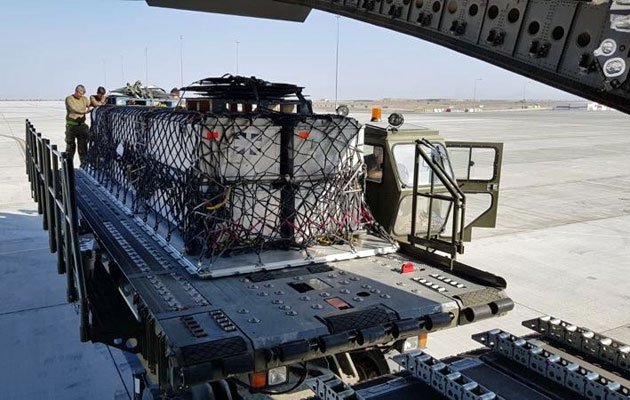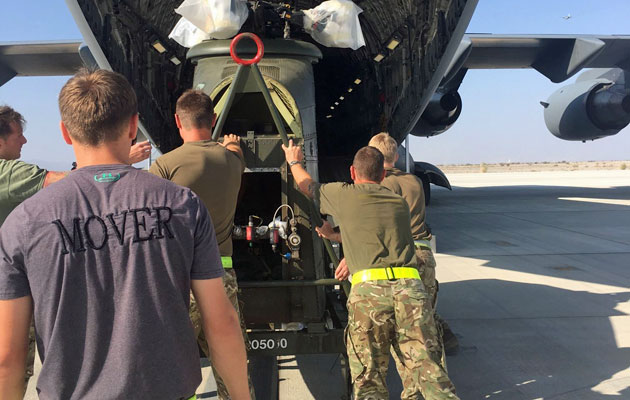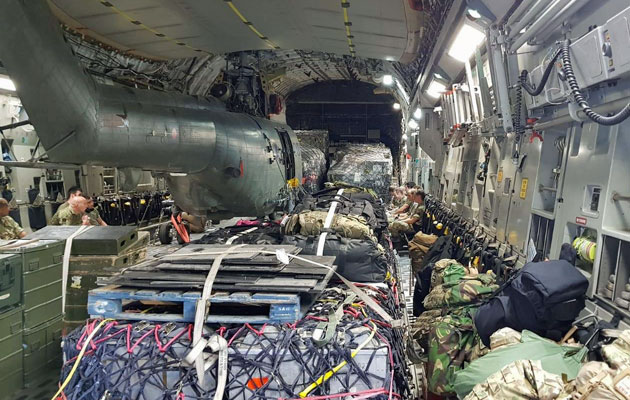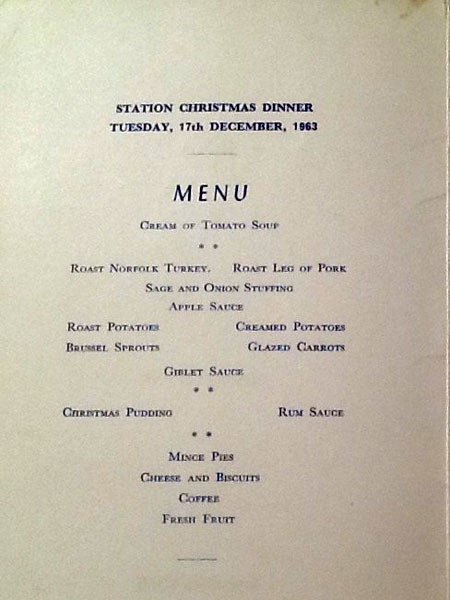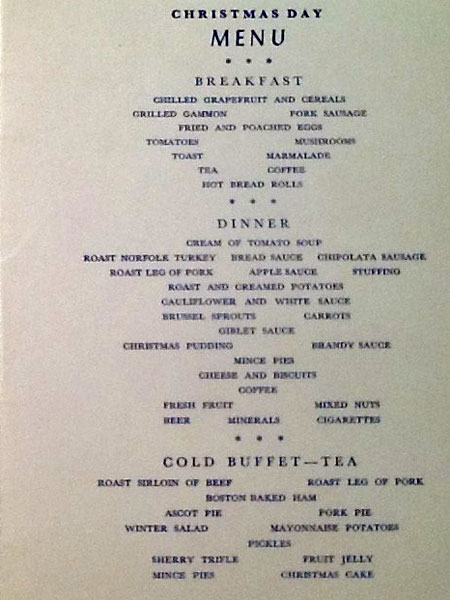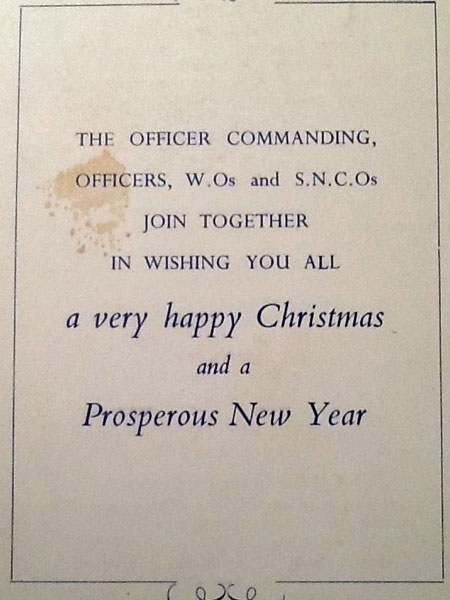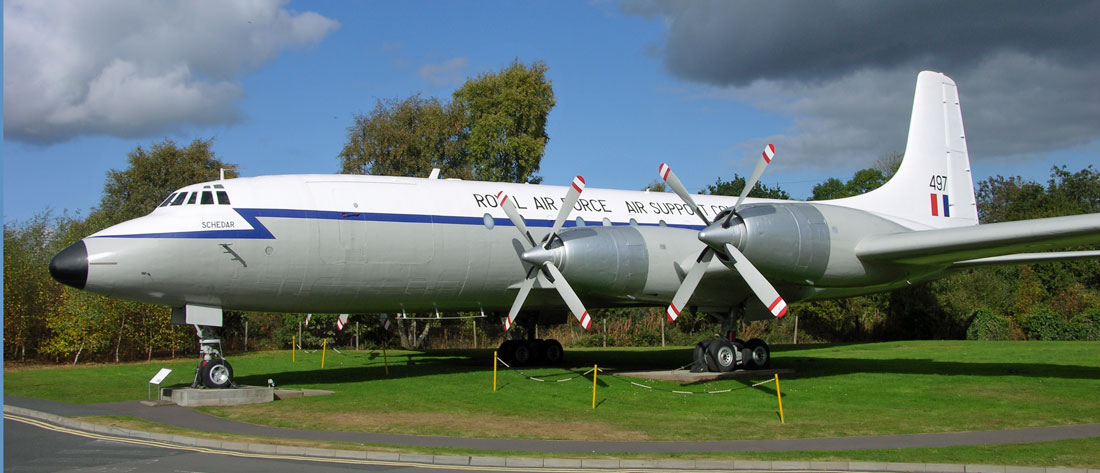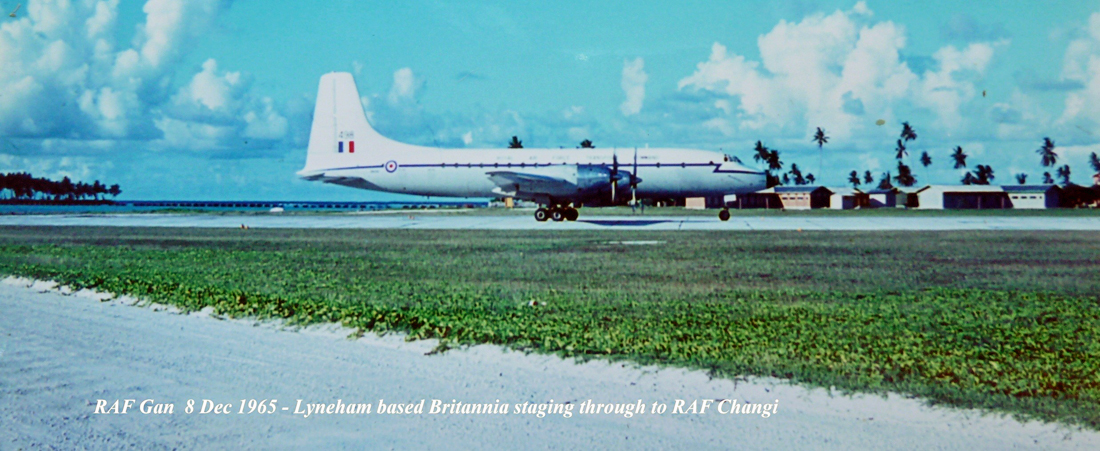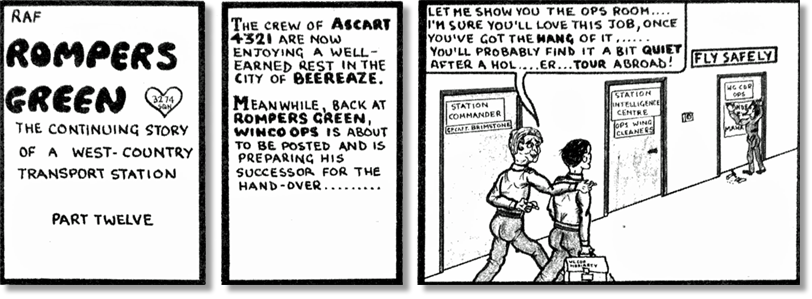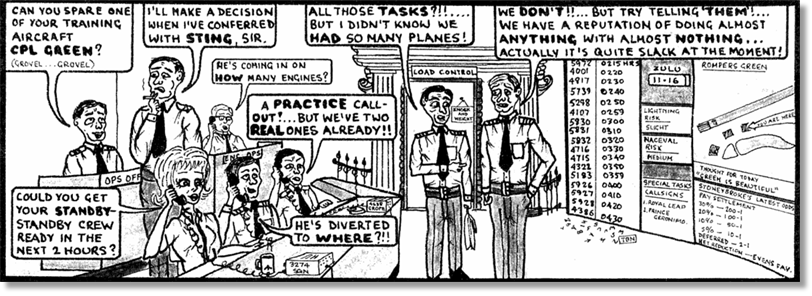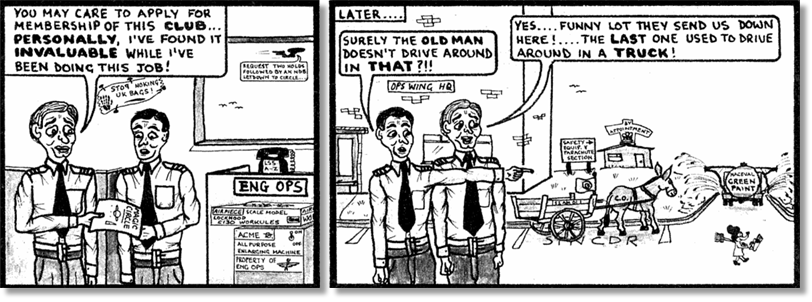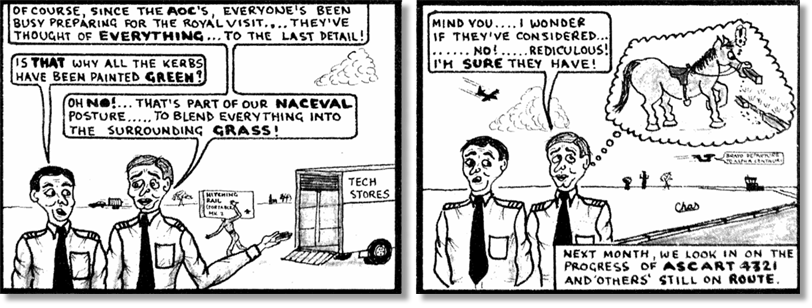


Wrapping up Saif Sareea III for Christmas
Since 1966, UKMAMS/1 AMW has been the ‘First In, Last Out’ of every major operation and exercise requiring the enablement of air transport activity. Most recently, Exercise Saif Sareea III, a combined British and Omani military exercise, was no different.
The whole process brought unique challenges including the first double Puma helicopter move with an Air Transportable Galley/Lavatory (ATGL) and the first Chinook with an ATGL move on a C-17 as well as the diversion to the airbridge of mission critical equipment originally destined to travel by sea.
After the other tri-service enabling groups had left the country in early December, a contingent of UK Mobile Air Movements Squadron personnel remained to process, build, prepare, load and despatch the outstanding exercise freight. Five days before Christmas the last Saif Sareea III presence in country departed on an A400M bound for the UK - displaying that after 52 years they are still the ‘First In, Last Out’.
Royal Air Force
The whole process brought unique challenges including the first double Puma helicopter move with an Air Transportable Galley/Lavatory (ATGL) and the first Chinook with an ATGL move on a C-17 as well as the diversion to the airbridge of mission critical equipment originally destined to travel by sea.
After the other tri-service enabling groups had left the country in early December, a contingent of UK Mobile Air Movements Squadron personnel remained to process, build, prepare, load and despatch the outstanding exercise freight. Five days before Christmas the last Saif Sareea III presence in country departed on an A400M bound for the UK - displaying that after 52 years they are still the ‘First In, Last Out’.
Royal Air Force
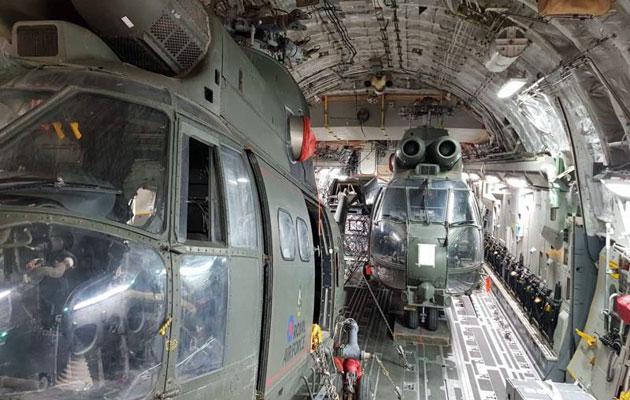

From: Ian Stacey, Nashville, IN
Subject: The Early Years - a tad late!
Hi Tony,
As you know I have recently moved from Illinois to Indiana and I am still in the throes, six months later, of unpacking boxes and trying to find all the unnecessary stuff that we keep from years gone by. I had intended to try and send you the attached picture for your edition of “The Early Years” but could not find it. Well, it just turned up and I am belatedly sending it to you in case you can still use it.
Subject: The Early Years - a tad late!
Hi Tony,
As you know I have recently moved from Illinois to Indiana and I am still in the throes, six months later, of unpacking boxes and trying to find all the unnecessary stuff that we keep from years gone by. I had intended to try and send you the attached picture for your edition of “The Early Years” but could not find it. Well, it just turned up and I am belatedly sending it to you in case you can still use it.

This a caricature of me done at Abingdon in 1965 by the cartoonist Pat Rooney. Rooney was quite a well-known artist in his time and was mostly known for his drawings of RAF personnel during WW2. It is not difficult to find his drawings on the internet and if you do a search for these, most of them are WW2 vintage. He died in 1966 at age 82 so must have been 81 when he did this of me. I found an article about him on the internet which explains:
“By the time war broke out in 1939 Rooney would have been fifty-five and was much in demand by members of the armed forces, travelling by train to RAF stations in particular. He would seek permission of the manager of the Officer’s Mess before setting-up shop, his first “commission” would probably cost nothing in order to generate interest and he would proceed then to produce “lightning” sketches, each taking five minutes or so and, for some reason, usually of the sitter’s left profile. The charge would be five shillings or seven-and-sixpence if a frame with passé-partout and glass was required."
Anyway – as you can see, Rooney has captured me at one of our favorite occupations of the time – downing a pint or two!!
He also added a couple of Blackburn Beverley’s in the picture and, if you look carefully, a couple of forklift trucks since I had told him that I was in Air Movements.
“By the time war broke out in 1939 Rooney would have been fifty-five and was much in demand by members of the armed forces, travelling by train to RAF stations in particular. He would seek permission of the manager of the Officer’s Mess before setting-up shop, his first “commission” would probably cost nothing in order to generate interest and he would proceed then to produce “lightning” sketches, each taking five minutes or so and, for some reason, usually of the sitter’s left profile. The charge would be five shillings or seven-and-sixpence if a frame with passé-partout and glass was required."
Anyway – as you can see, Rooney has captured me at one of our favorite occupations of the time – downing a pint or two!!
He also added a couple of Blackburn Beverley’s in the picture and, if you look carefully, a couple of forklift trucks since I had told him that I was in Air Movements.
I loved working with the Beverly’s, they were great aircraft. We had 47 squadron at Abingdon at that time and in the mess we were friends with many of the crew members, one of the captains, Jim Young, used to describe his Beverly as “50,000 rivets in loose formation!” Also, since the Beverly had a fixed undercarriage Jim used to love to tease air traffic controllers at other stations un-familiar with them. On final landing approach his response to the familiar call of “Finals – three greens” (3 green lights meaning that most retractable undercarriages were lowered) was “Undercarriage down and welded!”
Great days – weren’t we lucky to be there!
Cheers, Ian
Great days – weren’t we lucky to be there!
Cheers, Ian

Belated and Misplaced Christmas Messages
During the rush to get the Christmas newsletter out on time, I missed a few messages, plus there were some late arrivals, so here they are:

From: Stan Seggar, Sheffield
Subject: Christmas Greetings
Hi Tony,
All the best to you and all other ex Boy Entrants of C Flt, 3 Sqn, 50th Entry Suppliers, RAF Hereford 1963/65
Merry Christmas to all.
Stan Seggar (1949857)
Subject: Christmas Greetings
Hi Tony,
All the best to you and all other ex Boy Entrants of C Flt, 3 Sqn, 50th Entry Suppliers, RAF Hereford 1963/65
Merry Christmas to all.
Stan Seggar (1949857)
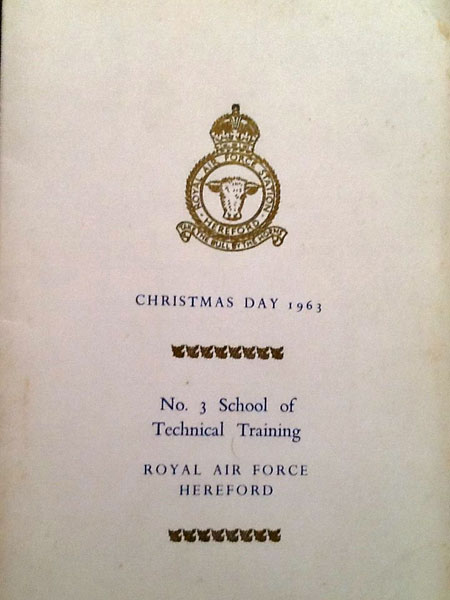

From: Howard Thomas, Caravonica, QLD
Subject: Christmas Greetings
Subject: Christmas Greetings
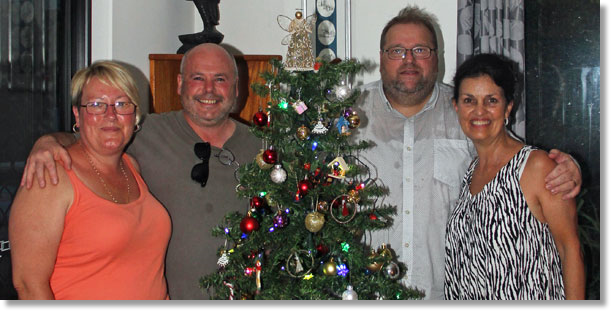
Pictured together for the first time in 28 years are Taff (Tony) Weale and his partner Wendy on a visit to Cairns, Australia with Howard (Thommo) Thomas and his missus Bronwyn.
We served on Air Movs at BZZ in 1980 - some 38 years ago. As with all good service friendships, within five minutes we were back in the crew room telling stories and laughing at times past!
Merry Xmas to you all.
Howard & Bronwyn
We served on Air Movs at BZZ in 1980 - some 38 years ago. As with all good service friendships, within five minutes we were back in the crew room telling stories and laughing at times past!
Merry Xmas to you all.
Howard & Bronwyn

From: Keith Simmonds, Nottingham
Subject: Christmas Greetings
Sorry, but I can't find a suitable picture - having a bit of a tough time at the moment with a sickness in the family. I met Merv Corke last week in Swindon - he's 88 now.
Merry Christmas and Happy New Year to all.
Keith
Subject: Christmas Greetings
Sorry, but I can't find a suitable picture - having a bit of a tough time at the moment with a sickness in the family. I met Merv Corke last week in Swindon - he's 88 now.
Merry Christmas and Happy New Year to all.
Keith

From: Basil Hughes, Pattaya
Subject: Greetings
Merry Christmas and a happy New Year to you and all the MAMS Family. Love and greetings from us all here in Thailand
Bas
Subject: Greetings
Merry Christmas and a happy New Year to you and all the MAMS Family. Love and greetings from us all here in Thailand
Bas

From: Neil Collie, Canberra, ACT
Subject: New Year Messages
Bugger! Missed the Xmas messages and note that OBie (RAAF) got one in! Anyway, Happy New Year to RAF and RAAF Movers everywhere. OK, even the RNZAF Movers, even Dave Milne.... just!
Cheers
Neil Collie
Subject: New Year Messages
Bugger! Missed the Xmas messages and note that OBie (RAAF) got one in! Anyway, Happy New Year to RAF and RAAF Movers everywhere. OK, even the RNZAF Movers, even Dave Milne.... just!
Cheers
Neil Collie

Wessex Helicopter Touchdown at Crumlin Road Gaol
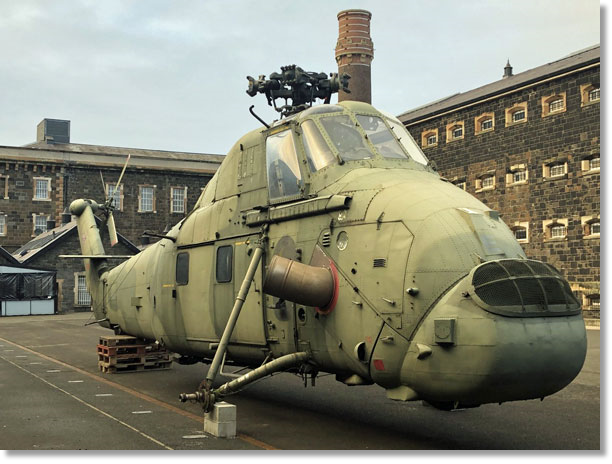
Yesterday evening, January 13th., Crumlin Road Gaol in Belfast took delivery of a decommissioned Westland Wessex helicopter from RAF Aldergrove. The Wessex XR 529 ‘ECHO’ will be the focal point of a new tour being launched at the 5-star visitor attraction in 2019.
Carefully guided into placed beside the Sanger at D Wing, the helicopter will be on display to visitors. It will give them an insight into the happenings during the conflict in Northern Ireland and tell the story which the British Army and RAF played both at the jail and in the wider community.
Once an iconic feature of the skyline in Northern Ireland, the helicopter was part of a batch of 30 HC2s built by Westland Aircraft Ltd. They were operated by 72 Squadron at RAF Aldergrove until 2002. 72 Squadron served in an Army support role and the Wessex was used as troop carrier for up to 16 passengers. It was decommissioned and displayed as the RAF Aldergrove Gate Guardian on 16th May 2003.
Phelim Devlin, Director at Crumlin Road Gaol commented “After several months of planning we are excited to finally see the Wessex arrive at Crumlin Road Gaol. The Wessex Helicopter will play an important part in the next phase of development at the jail.”
Carefully guided into placed beside the Sanger at D Wing, the helicopter will be on display to visitors. It will give them an insight into the happenings during the conflict in Northern Ireland and tell the story which the British Army and RAF played both at the jail and in the wider community.
Once an iconic feature of the skyline in Northern Ireland, the helicopter was part of a batch of 30 HC2s built by Westland Aircraft Ltd. They were operated by 72 Squadron at RAF Aldergrove until 2002. 72 Squadron served in an Army support role and the Wessex was used as troop carrier for up to 16 passengers. It was decommissioned and displayed as the RAF Aldergrove Gate Guardian on 16th May 2003.
Phelim Devlin, Director at Crumlin Road Gaol commented “After several months of planning we are excited to finally see the Wessex arrive at Crumlin Road Gaol. The Wessex Helicopter will play an important part in the next phase of development at the jail.”
He continued, “2019 will see the launch of a brand new tour at Crumlin Road Gaol which will cover all aspects of the more recent history here at this site and in the local area, including the insights from security services, loyalist and republican sides. This tour will provide an enhanced visitor experience at our 5 star visitor attraction in addition to contributing and enriching the growing tourism industry here in Belfast.”
RAF Northern Ireland Community Relations Officer, Wing Commander Tara Scott, said: “At the end of the Royal Air Force’s centenary year, we are pleased that the Wessex is moving to a new home where it will be on display to the public. Visitors will have the opportunity to learn the history of a helicopter that served the RAF for over 40 years from 1961 to 2002 including in a search and rescue role.”
lovebelfast.co.uk
RAF Northern Ireland Community Relations Officer, Wing Commander Tara Scott, said: “At the end of the Royal Air Force’s centenary year, we are pleased that the Wessex is moving to a new home where it will be on display to the public. Visitors will have the opportunity to learn the history of a helicopter that served the RAF for over 40 years from 1961 to 2002 including in a search and rescue role.”
lovebelfast.co.uk

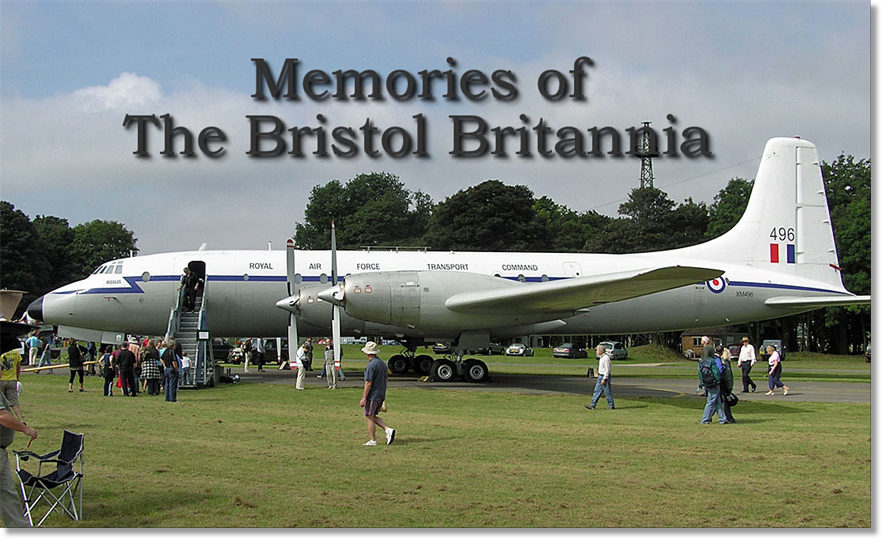

The Bristol Britannia
The Bristol Type 175 Britannia was a British medium-to-long-range airliner built by the Bristol Aeroplane Company in 1952 to fly across the British Empire. During development two prototypes were lost and the turboprop engines proved susceptible to inlet icing, which delayed entry into service while solutions were sought.
By the time development was completed, "pure" jet airliners from France, United Kingdom and the United States were about to enter service, and consequently, only 85 Britannias were built before production ended in 1960. Nevertheless, the Britannia is considered one of the landmarks in turboprop-powered airliner design and was popular with passengers. It became known as "The Whispering Giant" for its quiet exterior noise and smooth flying, although the passenger interior remained less tranquil.
Canadair purchased a licence to build the Britannia in Canada, adding another 72 variants. These were the stretched Canadair CL-44/Canadair CC-106 Yukon, and the greatly modified Canadair CP-107 Argus maritime patrol aircraft.
Wikipedia
By the time development was completed, "pure" jet airliners from France, United Kingdom and the United States were about to enter service, and consequently, only 85 Britannias were built before production ended in 1960. Nevertheless, the Britannia is considered one of the landmarks in turboprop-powered airliner design and was popular with passengers. It became known as "The Whispering Giant" for its quiet exterior noise and smooth flying, although the passenger interior remained less tranquil.
Canadair purchased a licence to build the Britannia in Canada, adding another 72 variants. These were the stretched Canadair CL-44/Canadair CC-106 Yukon, and the greatly modified Canadair CP-107 Argus maritime patrol aircraft.
Wikipedia

From: Christopher Briggs, Coventry, West Midlands
Subject: Memories of the Whispering Giant
Hi Tony,
My first encounter with the aircraft was when the Tutankhamun exhibition arrived in a Britannia at Brize. Someone had to guard it overnight and of course I was volunteered. I can honestly say it was the most chilling experience I have ever had; very creepy and eerie.
Secondly, I recall having to fly to Gibraltar on the Britannia to help the resident movers unload/load the scheduled aircraft. It was great as I was on the flight deck there and back. On approach to Gib the aircraft was bouncing about like a good one, then noticing that we were half way down the runway and not landing the pilot said we would have to go around again. If you remember it was when the airspace around Gib was limited so a very tight left hand turn was made. I still think it looked as if the wings were touching the water! Needless to say, on the second attempt we made it - just.
Subject: Memories of the Whispering Giant
Hi Tony,
My first encounter with the aircraft was when the Tutankhamun exhibition arrived in a Britannia at Brize. Someone had to guard it overnight and of course I was volunteered. I can honestly say it was the most chilling experience I have ever had; very creepy and eerie.
Secondly, I recall having to fly to Gibraltar on the Britannia to help the resident movers unload/load the scheduled aircraft. It was great as I was on the flight deck there and back. On approach to Gib the aircraft was bouncing about like a good one, then noticing that we were half way down the runway and not landing the pilot said we would have to go around again. If you remember it was when the airspace around Gib was limited so a very tight left hand turn was made. I still think it looked as if the wings were touching the water! Needless to say, on the second attempt we made it - just.
Thirdly was a flight out to and back from Masirah via Akrotiri. Such a quiet aircraft for its time, of course suitably named the Whispering Giant. I'll always remember the doors being opened on arrival at Masirah - the temperature inside the aircraft was nice and cool, but once the passenger door opened it was a sweltering 40ºC!
Who could forget the Britannia Freight Lift Platform (BFLP), what a nightmare that was! I could probably go on and on about the Britannia; a good old work horse that never seemed to let us down.
Cheers,
Chris B
Who could forget the Britannia Freight Lift Platform (BFLP), what a nightmare that was! I could probably go on and on about the Britannia; a good old work horse that never seemed to let us down.
Cheers,
Chris B

From: Gerry Davis, Bedminster
Subject: The Whispering Giant
Subject: The Whispering Giant
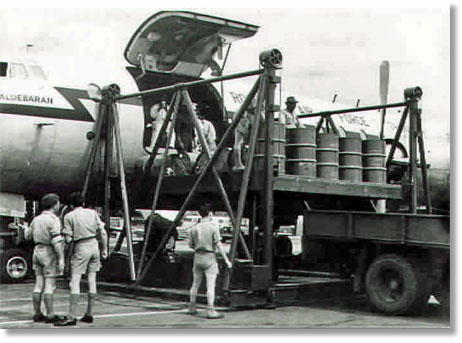
My time as an Air Mover, during the 60’s, is full of memories of working on the Britannias. I reckon I must have sweated on all of them, including the early ones without the freight door.
I recall some of the problems we encountered loading them. You had to be aware of the wind speed before opening the freight door. There were often difficulties in getting the ‘D’ rings into the floor especially if the previous load had been dusty.
If you were lucky you might have had a BFLP to help load the freight, either loose loaded or on pallets and of course vehicles. Not forgetting the workhorse of the Movers, the 12000lb fork lift.
I recall some of the problems we encountered loading them. You had to be aware of the wind speed before opening the freight door. There were often difficulties in getting the ‘D’ rings into the floor especially if the previous load had been dusty.
If you were lucky you might have had a BFLP to help load the freight, either loose loaded or on pallets and of course vehicles. Not forgetting the workhorse of the Movers, the 12000lb fork lift.
Above is a photo of a BFLP in use during the ‘Oil Lift’ which I spent 6 months in Nairobi on detachment during 1965/6. This was when Ian Smith declared Independence in Rhodesia. This machine was ‘Air portable’ when through sweat and toil it was disassembled.
There was of course a trim sheet to be filled out, in three copies, a red, blue and black one.
I also spent many an hour as a passenger flying between destinations, often having to offload it when we arrived. My three years on NEAF MAMS and the 3 years on shift at Lyneham, as the loading team corporal, fine-tuned me into the wonders of this long gone ‘Whispering Giant.’
Gerry Davis
There was of course a trim sheet to be filled out, in three copies, a red, blue and black one.
I also spent many an hour as a passenger flying between destinations, often having to offload it when we arrived. My three years on NEAF MAMS and the 3 years on shift at Lyneham, as the loading team corporal, fine-tuned me into the wonders of this long gone ‘Whispering Giant.’
Gerry Davis

From: Charles Gibson, Monifieth, Angus
Subject: Memories of the Whispering Giant
"Memories of the Whispering Giant" the best place to see them was RAF Lyneham (2 tours there Jan 66 to Dec 67) Station Air Movements. Was on Loading team on the pan and then ( Dec 70 to Dec 73 ) when I was married and in Load Control doing Britannia trim sheets.
Chas 43rd
Subject: Memories of the Whispering Giant
"Memories of the Whispering Giant" the best place to see them was RAF Lyneham (2 tours there Jan 66 to Dec 67) Station Air Movements. Was on Loading team on the pan and then ( Dec 70 to Dec 73 ) when I was married and in Load Control doing Britannia trim sheets.
Chas 43rd

From: John Bell, Desborough, Northants
Subject: Memories of the Whispering Giant
So many memories! Where to start?
The big one I suppose would be the Zambian Oil Lift. Day after day those of us at Nairobi loaded groups of 50 gallon drums onto plywood floor protection boards and tied them down with a necklace of chains. We developed the knack of rolling the full drums into place and then lifting them onto their ends with a ‘Snatch’ movement. No aids to do this. More than a few guys forgot to bend their knees and picked up problems with their backs that still linger around today. Some teams found it easier to load through the passenger door with a small fork lift truck. Of the hundreds of occasions we put the forks to the door I believe there were no accidents. I am sure someone will correct me if there were.
On my next detachment at the Lusaka end of the airlift the job was much easier, tipping the drums onto their sides and rolling them onto the fork tines, with backloads of empty drums. The climate and nature of the task meant that we normally worked in shorts and gloves; no shirts. (No aircrew overalls in those days). On one occasion the full team were working on a Brit when a visiting Air Officer came to observe. He asked who was in charge. Our young topless and oil smeared Flying Officer Team Leader identified himself. He was invited to leave the aircraft where he was on the receiving end of a one way chat. He returned onto the Brit a few minutes later, complete with shirt and rank braid. That same Air Officer was late for his flight back to Nairobi. The steps had been pulled away and the chocks removed. The captain would not allow us to put the steps back in so the Air Officer stood next to the marshaller, put his hand on his hips and waited until the captain powered down and opened the passenger door for us to put the steps back in.
On a task at El Adem, halfway through unloading a Brit, a long box was pushed through the freight door until only one third remained in the aircraft. To prevent it tipping I was told to sit on while the team went to fetch a truck to pick it up. The local SAMO came aboard and asked me where the rest of the team were. As I replied he became quite angry and told me to stand up when I spoke to him. I tried to explain what would happen if I did but he became more angry and louder. So I stood up and the box upended and slid out the door onto the ground outside. He charged off and no more was heard about it. The box and contents were, fortunately, undamaged.
Happy days!
Subject: Memories of the Whispering Giant
So many memories! Where to start?
The big one I suppose would be the Zambian Oil Lift. Day after day those of us at Nairobi loaded groups of 50 gallon drums onto plywood floor protection boards and tied them down with a necklace of chains. We developed the knack of rolling the full drums into place and then lifting them onto their ends with a ‘Snatch’ movement. No aids to do this. More than a few guys forgot to bend their knees and picked up problems with their backs that still linger around today. Some teams found it easier to load through the passenger door with a small fork lift truck. Of the hundreds of occasions we put the forks to the door I believe there were no accidents. I am sure someone will correct me if there were.
On my next detachment at the Lusaka end of the airlift the job was much easier, tipping the drums onto their sides and rolling them onto the fork tines, with backloads of empty drums. The climate and nature of the task meant that we normally worked in shorts and gloves; no shirts. (No aircrew overalls in those days). On one occasion the full team were working on a Brit when a visiting Air Officer came to observe. He asked who was in charge. Our young topless and oil smeared Flying Officer Team Leader identified himself. He was invited to leave the aircraft where he was on the receiving end of a one way chat. He returned onto the Brit a few minutes later, complete with shirt and rank braid. That same Air Officer was late for his flight back to Nairobi. The steps had been pulled away and the chocks removed. The captain would not allow us to put the steps back in so the Air Officer stood next to the marshaller, put his hand on his hips and waited until the captain powered down and opened the passenger door for us to put the steps back in.
On a task at El Adem, halfway through unloading a Brit, a long box was pushed through the freight door until only one third remained in the aircraft. To prevent it tipping I was told to sit on while the team went to fetch a truck to pick it up. The local SAMO came aboard and asked me where the rest of the team were. As I replied he became quite angry and told me to stand up when I spoke to him. I tried to explain what would happen if I did but he became more angry and louder. So I stood up and the box upended and slid out the door onto the ground outside. He charged off and no more was heard about it. The box and contents were, fortunately, undamaged.
Happy days!

From: Nigel Moore, Devauden, Monmouthshire
Subject: Memories of the Whispering Giant
Dear Tony,
Happy New year! The pub is still shut, the Gauls are restless and the coal mine is now flooded, but life in Wales continues.
I attach a photo of a Brit at Kathmandu airport taken during the Gurkha Airlift between Hong Kong and Nepal when we were stationed at Kai Tak - I believe it was taken by Brian Hunt who gave me a copy.
Kind regards,
Nigel
Subject: Memories of the Whispering Giant
Dear Tony,
Happy New year! The pub is still shut, the Gauls are restless and the coal mine is now flooded, but life in Wales continues.
I attach a photo of a Brit at Kathmandu airport taken during the Gurkha Airlift between Hong Kong and Nepal when we were stationed at Kai Tak - I believe it was taken by Brian Hunt who gave me a copy.
Kind regards,
Nigel
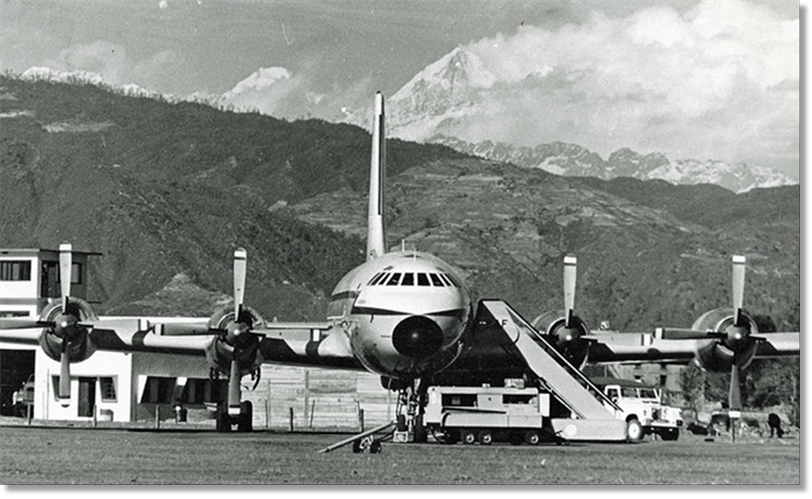

From: Bernie Hurdsfield, Corby, Northants
Subject: Memories of the Whispering Giant
Hello Tony,
My first memories of the Britannia were on my Air Movements course at Abingdon, loading and unloading the mock-up. We also spent time at Lyneham working with real loads under close supervision.
Having obtained my Q-EQ-AM qualification, I was posted to Air Movements at RAF Labuan in Borneo. This involved initially flying from London to Paya Lebar, Singapore, by a British Eagle Britannia, via Abadan (Iran) and Colombo (Ceylon), a distance of some 7,150 miles. This trip took about 30 hours in back in 1966. My tourex return a year later was again in a British Eagle Britannia, via Singapore, Bombay and Istanbul to London.
My next time working with the Britannia, was during my tour on Air Movements, Kai Tak, 1971 - 1973. The first direct air trooping of Gurkha's from Hong Kong to Kathmandu, Nepal took place during this period. This task involved working with UKMAMS, including yourself if my memory serves me right. I attach a photo of a first day cover to comemmerate it.
Best regards,
Bernie
Subject: Memories of the Whispering Giant
Hello Tony,
My first memories of the Britannia were on my Air Movements course at Abingdon, loading and unloading the mock-up. We also spent time at Lyneham working with real loads under close supervision.
Having obtained my Q-EQ-AM qualification, I was posted to Air Movements at RAF Labuan in Borneo. This involved initially flying from London to Paya Lebar, Singapore, by a British Eagle Britannia, via Abadan (Iran) and Colombo (Ceylon), a distance of some 7,150 miles. This trip took about 30 hours in back in 1966. My tourex return a year later was again in a British Eagle Britannia, via Singapore, Bombay and Istanbul to London.
My next time working with the Britannia, was during my tour on Air Movements, Kai Tak, 1971 - 1973. The first direct air trooping of Gurkha's from Hong Kong to Kathmandu, Nepal took place during this period. This task involved working with UKMAMS, including yourself if my memory serves me right. I attach a photo of a first day cover to comemmerate it.
Best regards,
Bernie


From: Mike Lefebvre, Burton, NB
Subject: Memories of the Whispering Giant
While employed at 2AMU Trenton, my first Britannia arrival, I was driving the stair truck. Of course I went to our usual door, the one we normally used when handling the Yukon. It took me a while to understand the RAF crew hand signals, never seen those before. They were telling me to go to the starboard door, we normally used the one on the port side. Learn something new every day.
Every Sunday morning we loaded the Yukon scheduled Flight 308 for Cyprus - doubled over in the front belly hold, bulk full of ration boxes. We put plywood on the rollers and made a human chain, cramped on our knees, sweating and with some of our manpower a little hung over from the previous evening. We never finished the job without an evacuation due to either Ray or Was letting one go. Many 2 AMU past members know these infamous two.
Vern Mike
Subject: Memories of the Whispering Giant
While employed at 2AMU Trenton, my first Britannia arrival, I was driving the stair truck. Of course I went to our usual door, the one we normally used when handling the Yukon. It took me a while to understand the RAF crew hand signals, never seen those before. They were telling me to go to the starboard door, we normally used the one on the port side. Learn something new every day.
Every Sunday morning we loaded the Yukon scheduled Flight 308 for Cyprus - doubled over in the front belly hold, bulk full of ration boxes. We put plywood on the rollers and made a human chain, cramped on our knees, sweating and with some of our manpower a little hung over from the previous evening. We never finished the job without an evacuation due to either Ray or Was letting one go. Many 2 AMU past members know these infamous two.
Vern Mike
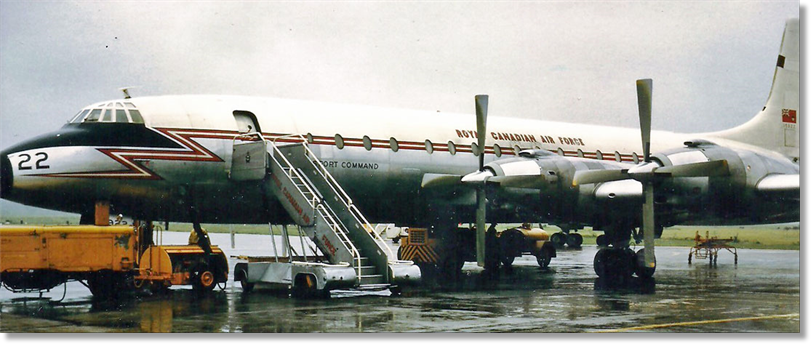

From: Tony Street, Buffalo, NY
Subject: The Canadair CC-160 Yukon
During the 1960's, about fifty percent of flights between Canada, Marville and Lahr were cargo flights. A load of servicemen with their dependants were rotated on day one, followed by their belongings and cargo on day two. This went on for a few years. I was a Yukon loadie for a few years (437 Squsdron, CYTR).
412 Squadron in Ottawa had a VIP Yukon with a very plush interior; even had it's own chef!
Cheers,
Tony
Subject: The Canadair CC-160 Yukon
During the 1960's, about fifty percent of flights between Canada, Marville and Lahr were cargo flights. A load of servicemen with their dependants were rotated on day one, followed by their belongings and cargo on day two. This went on for a few years. I was a Yukon loadie for a few years (437 Squsdron, CYTR).
412 Squadron in Ottawa had a VIP Yukon with a very plush interior; even had it's own chef!
Cheers,
Tony

From: Peter Thompson, Sunderland, Tyne and Wear
Subject: Memories of the Whispering Giant
What I mostly remember of the Britannia were the small and cramped belly holds, the unbelievably heavy and awkward TPU's (Tech Packups), but most of all leaving tufts of hair attached to the rivets along the roof of the hold. No wonder there were a lot of premature baldies in the trade! Apart from that I really liked the old girl.
Peter (Hammy) Thompson.
Subject: Memories of the Whispering Giant
What I mostly remember of the Britannia were the small and cramped belly holds, the unbelievably heavy and awkward TPU's (Tech Packups), but most of all leaving tufts of hair attached to the rivets along the roof of the hold. No wonder there were a lot of premature baldies in the trade! Apart from that I really liked the old girl.
Peter (Hammy) Thompson.

From: Howard Firth, Cranwell Village, Lincs
Subject: Memories of the Whispering Giant
Subject: Memories of the Whispering Giant
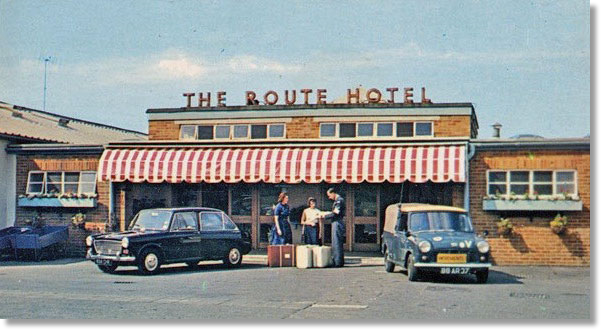
Hi Tony,
A Happy New Year to you and all members of UKMAMS OBA.
My initial introduction to working with this fine aircraft was on my first posting as a Mover in 1970 to RAF Lyneham where, as an SAC, I worked in the Route Hotel with Eddie Gordon.
Not long after my arrival the fleet was reassigned to Brize where I worked on A Shift Pax with Sgt Bob Campbell. Then followed tours in Gan, Luqa, Akrotiri and Wildenrath, although by then I think the aircraft had been retired.
Prompted by your request I dug out a couple of books on the subject both written by Sqn Ldr Dave Berry, father of SAC Mover Raz Berry. The first book is entitled, “The Whispering Giant in Uniform” and the second, “Tales from the Crew Room”.
A Happy New Year to you and all members of UKMAMS OBA.
My initial introduction to working with this fine aircraft was on my first posting as a Mover in 1970 to RAF Lyneham where, as an SAC, I worked in the Route Hotel with Eddie Gordon.
Not long after my arrival the fleet was reassigned to Brize where I worked on A Shift Pax with Sgt Bob Campbell. Then followed tours in Gan, Luqa, Akrotiri and Wildenrath, although by then I think the aircraft had been retired.
Prompted by your request I dug out a couple of books on the subject both written by Sqn Ldr Dave Berry, father of SAC Mover Raz Berry. The first book is entitled, “The Whispering Giant in Uniform” and the second, “Tales from the Crew Room”.
They are highly informative and humourous books and I would recommend them to both the young and old amongst us. Full of nostalgia, especially the chapter on the Changi Slip.
I look forward to reading the Movers stories of the “Brit” in the next edition. Off to South Africa tomorrow for 8 weeks to play golf and escape the UK weather.
Regards
“H” Firth
I look forward to reading the Movers stories of the “Brit” in the next edition. Off to South Africa tomorrow for 8 weeks to play golf and escape the UK weather.
Regards
“H” Firth
Further to "H" Firth's comments regarding the books written by Sqn Ldr Dave Berry about the Britannia - back in October 2000, David sent me a copy of his latest book at that time, "Specialist Aircrew". I've transcribed an excerpt from Chapter 20:
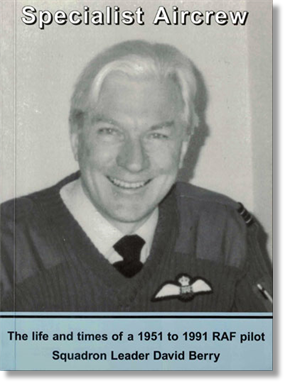
The start of 1970 found me cheerfully back in the left seat of a Britannia, at Lyneham, undergoing what was called ‘Retread Training’. It was to be hoped that by using this term, borrowed from the car tyre trade, was not a reflection on our perceived subsequent reliability.
Twenty-two hours of flying, which included a route trip to Malta and return, saw me considered ‘retreaded’ to sufficient quality to return to 99 Squadron.
My first trip? Well, not a full Changi Slip, but halfway there and return – and I was pleased to be back, doing just that.
It might be considered that my recent Britannia experience was pretty humble… but on my next trip I had royalty on board. We were due to fly an aircraft out of Cyprus to Lyneham. When reporting to Akrotiri Ops, the word was:
Twenty-two hours of flying, which included a route trip to Malta and return, saw me considered ‘retreaded’ to sufficient quality to return to 99 Squadron.
My first trip? Well, not a full Changi Slip, but halfway there and return – and I was pleased to be back, doing just that.
It might be considered that my recent Britannia experience was pretty humble… but on my next trip I had royalty on board. We were due to fly an aircraft out of Cyprus to Lyneham. When reporting to Akrotiri Ops, the word was:
“Your passengers are all Army – they’ve been on exercise here. Perhaps you should know that the Major in charge is HRH The Duke of Kent, but he wants to be treated as a normal passenger.
Well, that made life easy.
Off we set from Akrotiri, westwards over the various Greek islands; Rodos, Araxos, Milos, turning north west at Caraffa on the toe of Italy to fly up the west coast, then heading for Nice.
As was routine, we were listening to the hourly broadcasts of the latest weather at the UK airfields. Lyneham was fine but when we were passed the latest forecast, things did not look good; early morning fog was due to creep over the Lyneham Bank and sit over the airfield. We started making plans for a possible diversion airfield. At this stage, I decided that HRH could not be treated ‘as a normal passenger’. Hat on, I retired to the passenger cabin.
Well, that made life easy.
Off we set from Akrotiri, westwards over the various Greek islands; Rodos, Araxos, Milos, turning north west at Caraffa on the toe of Italy to fly up the west coast, then heading for Nice.
As was routine, we were listening to the hourly broadcasts of the latest weather at the UK airfields. Lyneham was fine but when we were passed the latest forecast, things did not look good; early morning fog was due to creep over the Lyneham Bank and sit over the airfield. We started making plans for a possible diversion airfield. At this stage, I decided that HRH could not be treated ‘as a normal passenger’. Hat on, I retired to the passenger cabin.
“It does look, Sir, as if we might not be able to land at Lyneham. Manchester looks like a strong bet. Is there anyone you would like us to inform?”
It seemed not, he was quite happy to continue ‘as a normal passenger’. As we approached the English Channel, the Met Men continued with their threat of fog at any moment, although the current visibility was good. We passed over London, turning west for Wiltshire and reducing height. Swindon came into sight and there, eight miles to the west, was the Lyneham runway, loud and clear. This was the way of things, more often than not.
As we settled on the final approach, I happened to glance over my shoulder and there was His Royal Highness, standing in the doorway, with a headset on, listening to all that was going on. The air quartermaster had thought it would be a good idea ‘to keep him in the picture’. I pointed out to this young man, later, that it would have also been a good idea to let us know what was happening. There could have been a lot of inappropriate flight deck banter – not an uncommon practice – perhaps on the topic of the reuniting of our ‘normal passenger’ and Her Royal Highness. Such reunion matters always weighed heavily on our minds for those last few hours before homecoming!
I will allude to the ‘new mix’ crew-wise, with which one started each trip. This could produce interest, amusement, tension or irritation. It would put a newcomer up to test as he demonstrated his abilities, both professional and social, to a critical audience – and adjusted himself to his new compatriots. For a trip to Cyprus, this April, my navigator was a recently arrived flight commander. These people had a double burden – settling in as a proficient crew member and establishing themselves in their executive role. My Squadron Leader navigator was trying very hard in all directions.
We had hired Akrotiri’s recreational mini-bus for a tour of the island. Lunch at the Paphos harbour-side, with its pelican, was a starting point. Moving on, we spotted a motor club hill climb and decided to view it from the terrace of a convenient tavern. The navigator had done a tour in Cyprus and there had been several occasions already where, for our benefit, he had aired his local knowledge. Now the recommendation was:
“Try Ouzo – it’s the Cyprus version of Pernod – yeah, goes cloudy when you add water… I’ll get them!”
The wizened, clad in black, landlady approaches.
“Six Ouzos please.”
It seemed not, he was quite happy to continue ‘as a normal passenger’. As we approached the English Channel, the Met Men continued with their threat of fog at any moment, although the current visibility was good. We passed over London, turning west for Wiltshire and reducing height. Swindon came into sight and there, eight miles to the west, was the Lyneham runway, loud and clear. This was the way of things, more often than not.
As we settled on the final approach, I happened to glance over my shoulder and there was His Royal Highness, standing in the doorway, with a headset on, listening to all that was going on. The air quartermaster had thought it would be a good idea ‘to keep him in the picture’. I pointed out to this young man, later, that it would have also been a good idea to let us know what was happening. There could have been a lot of inappropriate flight deck banter – not an uncommon practice – perhaps on the topic of the reuniting of our ‘normal passenger’ and Her Royal Highness. Such reunion matters always weighed heavily on our minds for those last few hours before homecoming!
I will allude to the ‘new mix’ crew-wise, with which one started each trip. This could produce interest, amusement, tension or irritation. It would put a newcomer up to test as he demonstrated his abilities, both professional and social, to a critical audience – and adjusted himself to his new compatriots. For a trip to Cyprus, this April, my navigator was a recently arrived flight commander. These people had a double burden – settling in as a proficient crew member and establishing themselves in their executive role. My Squadron Leader navigator was trying very hard in all directions.
We had hired Akrotiri’s recreational mini-bus for a tour of the island. Lunch at the Paphos harbour-side, with its pelican, was a starting point. Moving on, we spotted a motor club hill climb and decided to view it from the terrace of a convenient tavern. The navigator had done a tour in Cyprus and there had been several occasions already where, for our benefit, he had aired his local knowledge. Now the recommendation was:
“Try Ouzo – it’s the Cyprus version of Pernod – yeah, goes cloudy when you add water… I’ll get them!”
The wizened, clad in black, landlady approaches.
“Six Ouzos please.”
There is a look of disbelief on the old woman’s face, “Seecks?!!”
Navigator waves six fingers in the air and adopts the traditional course of action when a foreigner doesn’t understand – say the same thing again – but louder, “SIX OUZOS, PLEASE.”
The landlady shrugs her shoulders and shuffles off. We settle on the terrace chairs. The old lady reappears with a tray holding six glasses, a jug of water and six BOTTLES of Ouzo. With a fixed grin, the navigator had to put on the appearance of ‘that is what he had meant’. It now fell on us to back that by getting on and consuming same!
It has to be admitted that the bottles were only 35cl size but the contents were sufficient to upset the judgement of my crew; the engineer persuaded a local to lend him his rather decrepit looking horse to ride around the village square; the co-pilot fell in love with a Cypriot lady almost as old as the provider of our libation and our lady air quartermaster managed to lock herself in the toilet. I’ve never fancied that aniseed flavoured drink since.
It did seem we spent half our lives in Cyprus. If you were en route for Bahrain, Gan, Singapore, Hong Kong, an eastbound global trip, Nairobi, Australia – in fact all points east, then in this era, the first stop was Akrotiri. Cyprus itself generated flights with the large military presence on the island requiring support – and it was used as an exercise area. So, a trip to Akrotiri was a very familiar one and one that could be flown in an automatic way. From Lyneham, the routing over London, down over France, the west coast of Italy and then over the Greek islands was always the same. Leaving Athens control, the handover was to Nicosia Centre.
“Nicosia Centre, this is Ascot 6543 on handover from Athens at flight level 230.”
“Ascot 6543 Nicosia centre, roger. You are clear to descend to flight level 130.”
Nicosia, 6543, leaving 230 for 130.”
The height lock on the autopilot disengaged and the pitch control switch lowered the nose slightly. The speed increased from 240 knots, cruising, to the maximum permitted of 258 knots. At that speed the airspeed lock engaged. The outboard throttles moved to the backstop, followed by the inboards. The needle on the altimeter wound rapidly anti-clockwise as the height decreased.
“Nicosia, Ascot 6543 passing 150 for 130.”
Navigator waves six fingers in the air and adopts the traditional course of action when a foreigner doesn’t understand – say the same thing again – but louder, “SIX OUZOS, PLEASE.”
The landlady shrugs her shoulders and shuffles off. We settle on the terrace chairs. The old lady reappears with a tray holding six glasses, a jug of water and six BOTTLES of Ouzo. With a fixed grin, the navigator had to put on the appearance of ‘that is what he had meant’. It now fell on us to back that by getting on and consuming same!
It has to be admitted that the bottles were only 35cl size but the contents were sufficient to upset the judgement of my crew; the engineer persuaded a local to lend him his rather decrepit looking horse to ride around the village square; the co-pilot fell in love with a Cypriot lady almost as old as the provider of our libation and our lady air quartermaster managed to lock herself in the toilet. I’ve never fancied that aniseed flavoured drink since.
It did seem we spent half our lives in Cyprus. If you were en route for Bahrain, Gan, Singapore, Hong Kong, an eastbound global trip, Nairobi, Australia – in fact all points east, then in this era, the first stop was Akrotiri. Cyprus itself generated flights with the large military presence on the island requiring support – and it was used as an exercise area. So, a trip to Akrotiri was a very familiar one and one that could be flown in an automatic way. From Lyneham, the routing over London, down over France, the west coast of Italy and then over the Greek islands was always the same. Leaving Athens control, the handover was to Nicosia Centre.
“Nicosia Centre, this is Ascot 6543 on handover from Athens at flight level 230.”
“Ascot 6543 Nicosia centre, roger. You are clear to descend to flight level 130.”
Nicosia, 6543, leaving 230 for 130.”
The height lock on the autopilot disengaged and the pitch control switch lowered the nose slightly. The speed increased from 240 knots, cruising, to the maximum permitted of 258 knots. At that speed the airspeed lock engaged. The outboard throttles moved to the backstop, followed by the inboards. The needle on the altimeter wound rapidly anti-clockwise as the height decreased.
“Nicosia, Ascot 6543 passing 150 for 130.”
“Roger 6543, contact Akrotiri approach on two three fife decimal three. Good day, Sir.”
“6543, Good day.”
The frequency dial on the UHF set clicked around to the pre-selected frequency for approach. The UHF buttons on the communications boxes at crew member’s stations popped in.
The autopilot airspeed lock went in and the pitch control switch flicked back in blips to level the aircraft. On reaching flight level 130, the height lock came out and, as the speed dropped, the throttles moved forward to give sufficient power to maintain 200 knots.
“Akrotiri approach, this is Ascot 6543, flight level 130. Request further descent.”
“Ascot 6543, Akrotiri, you’re loud and clear, continue descent to two thousand feet. QFE one zero one zero.”
“Roger, 6543 re-cleared to two thousand, one zero one zero is set, leaving 130.”
The height knob clicks in, twists through 180º and comes out to engage the airspeed lock. In pairs the throttles come back to ‘Flight Idle’.
On the Tacan, the range from Akrotiri clicks down. It is a mid-summer night, clear but with the lights on the ground shimmering in the remains of the daytime heat. From a range of ten miles it is the lights of Akrotiri that are flickering in the distance.
“Akrotiri approach, 6543, airfield in sight, request join downwind for a visual circuit.”
“6543, clear join, call tower on two three two decimal one.”
The aircraft is now passing 2000 feet and once again the airspeed/height lock clicks in and the pitch control blips back to slow the rate of descent. The airspeed is allowed to decay.
“Akrotiri tower, Ascot 6543 is downwind to land.”
“Roger 6543, call turning finals, the wind two niner zero at fife knots.”
“6543, Good day.”
The frequency dial on the UHF set clicked around to the pre-selected frequency for approach. The UHF buttons on the communications boxes at crew member’s stations popped in.
The autopilot airspeed lock went in and the pitch control switch flicked back in blips to level the aircraft. On reaching flight level 130, the height lock came out and, as the speed dropped, the throttles moved forward to give sufficient power to maintain 200 knots.
“Akrotiri approach, this is Ascot 6543, flight level 130. Request further descent.”
“Ascot 6543, Akrotiri, you’re loud and clear, continue descent to two thousand feet. QFE one zero one zero.”
“Roger, 6543 re-cleared to two thousand, one zero one zero is set, leaving 130.”
The height knob clicks in, twists through 180º and comes out to engage the airspeed lock. In pairs the throttles come back to ‘Flight Idle’.
On the Tacan, the range from Akrotiri clicks down. It is a mid-summer night, clear but with the lights on the ground shimmering in the remains of the daytime heat. From a range of ten miles it is the lights of Akrotiri that are flickering in the distance.
“Akrotiri approach, 6543, airfield in sight, request join downwind for a visual circuit.”
“6543, clear join, call tower on two three two decimal one.”
The aircraft is now passing 2000 feet and once again the airspeed/height lock clicks in and the pitch control blips back to slow the rate of descent. The airspeed is allowed to decay.
“Akrotiri tower, Ascot 6543 is downwind to land.”
“Roger 6543, call turning finals, the wind two niner zero at fife knots.”
Time for the autopilot to disengage. A perfect night, made moreso with a gentle wind right down the runway. Approaching 1000 feet, there is a whine as the flaps run to the 15º position. The throttles advance to give 250lbs of torque. The speed stabilises at 160 knots as the aircraft gently banks to the left to take up the downwind heading of 110º.
There is an increase in the roar from the airflow as the undercarriage starts to lower; two powerful clunks and one lesser one signal that the main and nose wheels are down and locked. The three undercarriage indicator lights have gone from off to shine red then green to indicate this. A little more power is needed to maintain 150 knots. Opposite to the upwind of the runway the aircraft banks and the nose drops. The throttles come back to give 200lbs of torque. There is that whine once more as the flaps move to the 30º position. The speed falls off to 140 knots.
“Tower, 6543 is turning finals with three greens to land.”
“6543 is clear to land, wind still two niner zero at fife knots.”
“6543.”
The turn continues; bank is adjusted as the runway comes into sight ahead. Two beams of light appear below the wings and rotate upwards to shine ahead; the landing lamp switch had moved to the ‘on’ position. The power setting is spot on; the angle of approach indicator lights on either side of the runway show green/red – also spot on. At 400 feet the speed is 130 knots; the whine again as the flaps lower to 45º. The nose has to be lowered to prevent the speed falling too low; it settles at 120 knots, 5 knots above the threshold speed – once again, spot on. The trim wheels are rotating forward to adjust for the lowering of full flaps.
The approach lights are now glaring up on the underside of the aircraft and the red lights marking the runway threshold are crossed. The ground looms up but the control column moves back to hold the aircraft level just above the ground; the throttles retract to the flight idle position. As the speed falls off, the control column comes back and back and then the main wheels kiss the runway surface. (This didn’t always happen with a Britannia landing!)
The noise level increases with the rumble of the tyres; the control column moves gently forward to place the nose wheel on the ground. There is the sound of a hammer blow – that is ‘Superfine’ being engaged. This reduces the angle of the propeller blades, below that used in flight, to allow the propellers to run fast enough on the ground to keep the alternators on line.
There is an increase in the roar from the airflow as the undercarriage starts to lower; two powerful clunks and one lesser one signal that the main and nose wheels are down and locked. The three undercarriage indicator lights have gone from off to shine red then green to indicate this. A little more power is needed to maintain 150 knots. Opposite to the upwind of the runway the aircraft banks and the nose drops. The throttles come back to give 200lbs of torque. There is that whine once more as the flaps move to the 30º position. The speed falls off to 140 knots.
“Tower, 6543 is turning finals with three greens to land.”
“6543 is clear to land, wind still two niner zero at fife knots.”
“6543.”
The turn continues; bank is adjusted as the runway comes into sight ahead. Two beams of light appear below the wings and rotate upwards to shine ahead; the landing lamp switch had moved to the ‘on’ position. The power setting is spot on; the angle of approach indicator lights on either side of the runway show green/red – also spot on. At 400 feet the speed is 130 knots; the whine again as the flaps lower to 45º. The nose has to be lowered to prevent the speed falling too low; it settles at 120 knots, 5 knots above the threshold speed – once again, spot on. The trim wheels are rotating forward to adjust for the lowering of full flaps.
The approach lights are now glaring up on the underside of the aircraft and the red lights marking the runway threshold are crossed. The ground looms up but the control column moves back to hold the aircraft level just above the ground; the throttles retract to the flight idle position. As the speed falls off, the control column comes back and back and then the main wheels kiss the runway surface. (This didn’t always happen with a Britannia landing!)
The noise level increases with the rumble of the tyres; the control column moves gently forward to place the nose wheel on the ground. There is the sound of a hammer blow – that is ‘Superfine’ being engaged. This reduces the angle of the propeller blades, below that used in flight, to allow the propellers to run fast enough on the ground to keep the alternators on line.
The foot brakes on the rudder pedals depress and the slight jerk on the aircraft confirms that the brakes are working. With that, the throttles move forward to the position they were in for touch-down. This will now give ‘ground-idle’ power from the engines.
A lever to the right of the throttles moves rearwards and five red lights illuminate on the centre of the instrument panel coaming – the controls are locked. Once more, there is the distinctive sound of the flap motors as the flaps are raised, fully up.
The aircraft trundles up to the end of the runway and turns left. The intensity of the landing lights is reduced as the landing light switch moves to the taxy lamp position. The taxiway curves round to the left and then there is a sharp right turn into the parking area.
Ahead, the illumination wands of the ground marshaller beckon. The taxy lamp switch goes top off. As the aircraft reached the required spot the marshaller crosses his wands over his head. The brakes go fully on and the parking brake lever clicks on its ratchet.
Switches now move rapidly; there is a clunk as the superfine switch moves; the four high pressure switches go to off; the engine noise immediately dies. As the rpm falls away, more switches move to close the low-pressure fuel and the oil cocks. Brakes to the propellers go on and as they come to a standstill, the underside flashing red light extinguishes indicating to the ground crew that it is safe to approach the aircraft. The noise outside is the ground power unit starting up. A green light on the electrical panel indicates that it is ready to supply current to the aircraft.
The Movements Staff, who will be attending to the load, push a set of steps to the rear door of the aircraft. Tradition dictates that they do not mount these yet. They wait for the air quartermaster to open the door from inside the aircraft and descend the steps to hand over the necessary paperwork and brief the Movements Officer on the requirements.
With the engines stopped, aircraft exterior lights extinguished and steps in position, the scene is much calmer now, although the grinding of the ground power unit does not allow complete peace.
The Movers wait for the door to open, but it remains shut. They wait patiently. Minutes tick by – something is clearly wrong. The officer leads the way up the steps and the door is opened from the outside. The ground team step into the aircraft… no air quartermaster… the passenger/freight cabin is deserted.
“He must be on the flight deck,” volunteers the officer.
A lever to the right of the throttles moves rearwards and five red lights illuminate on the centre of the instrument panel coaming – the controls are locked. Once more, there is the distinctive sound of the flap motors as the flaps are raised, fully up.
The aircraft trundles up to the end of the runway and turns left. The intensity of the landing lights is reduced as the landing light switch moves to the taxy lamp position. The taxiway curves round to the left and then there is a sharp right turn into the parking area.
Ahead, the illumination wands of the ground marshaller beckon. The taxy lamp switch goes top off. As the aircraft reached the required spot the marshaller crosses his wands over his head. The brakes go fully on and the parking brake lever clicks on its ratchet.
Switches now move rapidly; there is a clunk as the superfine switch moves; the four high pressure switches go to off; the engine noise immediately dies. As the rpm falls away, more switches move to close the low-pressure fuel and the oil cocks. Brakes to the propellers go on and as they come to a standstill, the underside flashing red light extinguishes indicating to the ground crew that it is safe to approach the aircraft. The noise outside is the ground power unit starting up. A green light on the electrical panel indicates that it is ready to supply current to the aircraft.
The Movements Staff, who will be attending to the load, push a set of steps to the rear door of the aircraft. Tradition dictates that they do not mount these yet. They wait for the air quartermaster to open the door from inside the aircraft and descend the steps to hand over the necessary paperwork and brief the Movements Officer on the requirements.
With the engines stopped, aircraft exterior lights extinguished and steps in position, the scene is much calmer now, although the grinding of the ground power unit does not allow complete peace.
The Movers wait for the door to open, but it remains shut. They wait patiently. Minutes tick by – something is clearly wrong. The officer leads the way up the steps and the door is opened from the outside. The ground team step into the aircraft… no air quartermaster… the passenger/freight cabin is deserted.
“He must be on the flight deck,” volunteers the officer.
He moves up the cabin, past the lashed-down freight and opens the flight deck door. No one… all five crew seats are empty. There is a double click to his right… he looks down… it’s the electrical panel and he sees two switches rotating, unaided, from the ‘Flight’ position to ‘Ground’.
It is the ‘Marie Celeste’ revisited – the aircraft has flown to Akrotiri so many times that, on this occasion, it has got there all by itself!
The Movements Officer rushes down the cabin and steps and grabs the radio in his Land Rover. He struggles to control his voice as he calls his superior, the Senior Air Movements Officer.
“6543 - just landed – taxied in – but there’s no one on board!”
“Well, there wouldn’t be, the crew are up here in the Transit Lounge Bar having their wind-down beers…"
It is the ‘Marie Celeste’ revisited – the aircraft has flown to Akrotiri so many times that, on this occasion, it has got there all by itself!
The Movements Officer rushes down the cabin and steps and grabs the radio in his Land Rover. He struggles to control his voice as he calls his superior, the Senior Air Movements Officer.
“6543 - just landed – taxied in – but there’s no one on board!”
“Well, there wouldn’t be, the crew are up here in the Transit Lounge Bar having their wind-down beers…"


From: Jim Nadin, Lincoln
Subject: Memories of the Whispering Giant
Hi Tony,
Happy New Year to you also.
My one and only memory of the Whispering Giant was at Coltishall in 1968. As a very wet behind the ears LAC whose first ever flight was an air experience sortie in a Hastings from Scampton, the Britannia was something completely different. As I recall, she had dropped into Coltishall to pick up a Lightning fly away pack for a forthcoming Cyprus detachment and I was nominated to assist in the ‘humping and dumping’ of the crates.
The loadmaster invited me on board and I was simply awe struck by the cavernous interior. Even more so when he told me that 50 or more stretchers, medical staff and life saving equipment could be carried. I was impressed but sadly never got to fly in one although some I have spoken to were less enthusiastic about their passenger experiences.
Best wishes
Jim
Subject: Memories of the Whispering Giant
Hi Tony,
Happy New Year to you also.
My one and only memory of the Whispering Giant was at Coltishall in 1968. As a very wet behind the ears LAC whose first ever flight was an air experience sortie in a Hastings from Scampton, the Britannia was something completely different. As I recall, she had dropped into Coltishall to pick up a Lightning fly away pack for a forthcoming Cyprus detachment and I was nominated to assist in the ‘humping and dumping’ of the crates.
The loadmaster invited me on board and I was simply awe struck by the cavernous interior. Even more so when he told me that 50 or more stretchers, medical staff and life saving equipment could be carried. I was impressed but sadly never got to fly in one although some I have spoken to were less enthusiastic about their passenger experiences.
Best wishes
Jim

From: John Holloway, Shrewsbury, Salop
Subject: Memories of the Whispering Giant
Hi Tony,
The only Britannia I've seen in RAF colours is the one at the RAF Museum at Cosford; it arrived back in the 80's and was in BOAC livery, G-AOVF. It was eventually repainted in false RAF colours as "Schedar" XM497.
Subject: Memories of the Whispering Giant
Hi Tony,
The only Britannia I've seen in RAF colours is the one at the RAF Museum at Cosford; it arrived back in the 80's and was in BOAC livery, G-AOVF. It was eventually repainted in false RAF colours as "Schedar" XM497.
In October 1956, I was posted to Khormaksar from HQBF when we invaded Suez, so all scheduled flights went out of the window. All sorts of aircraft were arriving and on one occasion Air Trafic Control phoned us informing us that we had two Britannia's arriving and, as usual, informed us of any officers on board. One of them had a forward party of The King's Shropshire Light Infantry (KSLI) my home county regiment, and the officer i/c was Lt John McKiernan, an old school pal!
So, of course I made a point of going out with the meeting party when the kite arrived and parked and stood at the bottom of the steps as the passengers disembarked. The Brits were in BOAC livery as the MoD were commandeering aircraft just like many years later with the Falklands and the ships that were needed. Anyhow, Mac eventually appeared, came down the steps where I met him and I can't recall what was said, but he hadn't a clue where he was or where he was going which was to be next day by Valetta to Bahrain.
As I said, all sorts of aircraft were arriving, mainly Avro Yorks and Tudors carrying freight. To see a Tudor landing at night was quite a sight when the engines throttled back with the flames coming out of the exhausts and the crackle of the engines.
One night we had to unload the freight off a York and it would be in the dark as it was being refuelled and the only lights were on the ground. I had a roll of barbed wire fall against my legs and I've still got the scars to show for it!
Cheers
John
So, of course I made a point of going out with the meeting party when the kite arrived and parked and stood at the bottom of the steps as the passengers disembarked. The Brits were in BOAC livery as the MoD were commandeering aircraft just like many years later with the Falklands and the ships that were needed. Anyhow, Mac eventually appeared, came down the steps where I met him and I can't recall what was said, but he hadn't a clue where he was or where he was going which was to be next day by Valetta to Bahrain.
As I said, all sorts of aircraft were arriving, mainly Avro Yorks and Tudors carrying freight. To see a Tudor landing at night was quite a sight when the engines throttled back with the flames coming out of the exhausts and the crackle of the engines.
One night we had to unload the freight off a York and it would be in the dark as it was being refuelled and the only lights were on the ground. I had a roll of barbed wire fall against my legs and I've still got the scars to show for it!
Cheers
John
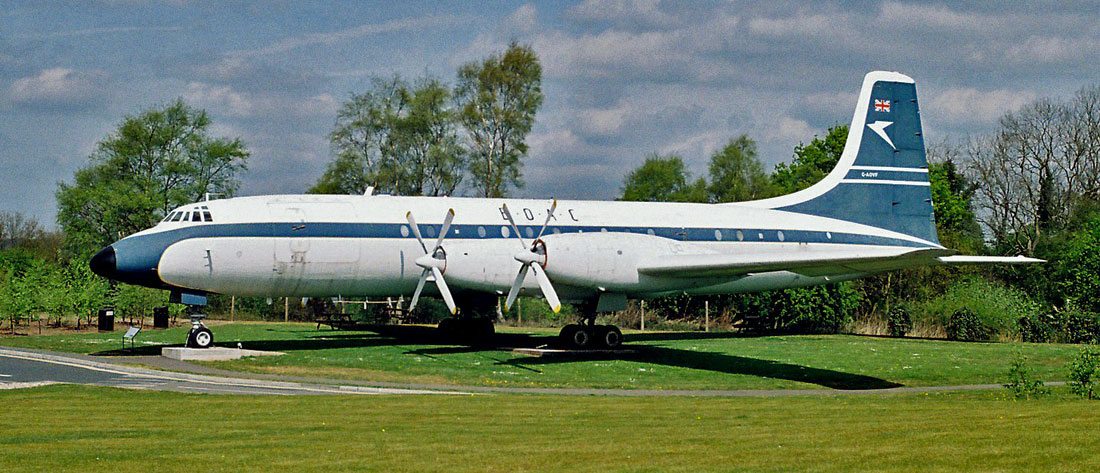

From: Howard Farrow, Swansea, Glamorgan
Subject: Memories of the Britannia
As a Brize Mover in 1972, I was posted to RAF Masirah for a stint in the sun. My flight from Brize was to be on a 99 Sqn Britannia. As I had been working on C shift Pax, the lads had managed to allocate me a main door triple to myself - Movers perk!
On saying cheerio to the lads, the door was closed and I settled back in comfort, the engines wound up and we abruptly left the bay only for me to find myself looking up at the cabin ceiling; the triple had not been fitted properly and was lying across the legs of three army lads in the row behind! The aircraft stopped, steps went in and two red-faced Role Equippers came on to great applause!
The rest of the flight was thankfully uneventful, staging at Akrotiri before landing at Masirah where I was met by members of my new shift. One of them put his arm around my shoulder and remarked 'how white I looked' and 'that nobody had that many days to do!" That was the great Mover Dave Wall!
That was my first and last flight on a Brit!
Howard (Taff) Farrow
Subject: Memories of the Britannia
As a Brize Mover in 1972, I was posted to RAF Masirah for a stint in the sun. My flight from Brize was to be on a 99 Sqn Britannia. As I had been working on C shift Pax, the lads had managed to allocate me a main door triple to myself - Movers perk!
On saying cheerio to the lads, the door was closed and I settled back in comfort, the engines wound up and we abruptly left the bay only for me to find myself looking up at the cabin ceiling; the triple had not been fitted properly and was lying across the legs of three army lads in the row behind! The aircraft stopped, steps went in and two red-faced Role Equippers came on to great applause!
The rest of the flight was thankfully uneventful, staging at Akrotiri before landing at Masirah where I was met by members of my new shift. One of them put his arm around my shoulder and remarked 'how white I looked' and 'that nobody had that many days to do!" That was the great Mover Dave Wall!
That was my first and last flight on a Brit!
Howard (Taff) Farrow
From: David Forsyth, Le Langon
Subject: Memories of the Whispering Giant
Subject: Memories of the Whispering Giant
What have you done, Norrie?
I have included names in this Britannia story as I am sure readers, like me, enjoy Tony’s Newletters for the names which come as blasts from the past. Unfortunately, the hero of the story, Norrie, is no longer answering roll calls but I hope he would have enjoyed being reminded of this little caper- then again, maybe not?
Word that a big exercise, Bersatu Padu, was to take place in 1970 began to circulate at Marham just after the Tanker Force had featured successfully in the Daily Mail Air Race, in-flight re-fuelling a Harrier and a Canberra on their way to and from New York. Morale at Marham was sky high as it was clear that 55, 57 and 214 Squadrons’ Victors, underpowered as they were, were then the best in the world at Air to Air Refuelling and all the complex planning which went into it.
I was fresh out of Cranwell, pilot officer “commanding” (for which read: “being kept right by Flight Seargent Jack”) the ESG at Marham- an organisation heavily solicited, with its electrical engineering techie peers, to enable the Victors do what they did so well. Fly Away Packs (FAPs) for Victor detachments were large, heavy affairs amounting to several thousand lbs and several dozen different sized wooden boxes (no ISOFIX stuff then) as well as large amounts of ground support equipment. Detachment FAPs were generally managed by a corporal or a sergeant and a couple of airmen. I was keen to get an overseas trip so prevailed upon mates in the flying squadrons to persuade their bosses that such an important exercise needed the presence of a pilot officer!
The first deployment to support Lightnings transiting to Singapore was from Marham to Luqa, lasting a week or so, then moving on to Akrotiri for another week or so prior to returning to Marham, the 'Giant Norfolk Air Base' as it had been termed in a Daily Mail article about their race to New York. Flying Officer George Hutt, the officer in charge of FAPs, his team and a MAMS team loaded all the kit plus a gaggle of techies and spare aircrew on to a Britannia and off we trundled to Luqa in Malta. I had not actively participated in loading and trimming the aircraft but George had briefed me on what was where and I had all the manifests and other papers in a nav bag I had persuaded clothing stores to lend me.
Arrival early evening in Luqa, we were met by the SAMO, I think that was Brian Everett, Richard Johnson (Load Control Officer) and Norrie Radcliffe (DAMO). My offer to help with the unloading was quickly turned down by Norrie who probably did not need or deserve his team being slowed down by the likes of me. “Off you go to the Mess, your stuff will be delivered to Sunspot in the morning” was Norrie’s sound advice, and I needed no second bidding.
Word that a big exercise, Bersatu Padu, was to take place in 1970 began to circulate at Marham just after the Tanker Force had featured successfully in the Daily Mail Air Race, in-flight re-fuelling a Harrier and a Canberra on their way to and from New York. Morale at Marham was sky high as it was clear that 55, 57 and 214 Squadrons’ Victors, underpowered as they were, were then the best in the world at Air to Air Refuelling and all the complex planning which went into it.
I was fresh out of Cranwell, pilot officer “commanding” (for which read: “being kept right by Flight Seargent Jack”) the ESG at Marham- an organisation heavily solicited, with its electrical engineering techie peers, to enable the Victors do what they did so well. Fly Away Packs (FAPs) for Victor detachments were large, heavy affairs amounting to several thousand lbs and several dozen different sized wooden boxes (no ISOFIX stuff then) as well as large amounts of ground support equipment. Detachment FAPs were generally managed by a corporal or a sergeant and a couple of airmen. I was keen to get an overseas trip so prevailed upon mates in the flying squadrons to persuade their bosses that such an important exercise needed the presence of a pilot officer!
The first deployment to support Lightnings transiting to Singapore was from Marham to Luqa, lasting a week or so, then moving on to Akrotiri for another week or so prior to returning to Marham, the 'Giant Norfolk Air Base' as it had been termed in a Daily Mail article about their race to New York. Flying Officer George Hutt, the officer in charge of FAPs, his team and a MAMS team loaded all the kit plus a gaggle of techies and spare aircrew on to a Britannia and off we trundled to Luqa in Malta. I had not actively participated in loading and trimming the aircraft but George had briefed me on what was where and I had all the manifests and other papers in a nav bag I had persuaded clothing stores to lend me.
Arrival early evening in Luqa, we were met by the SAMO, I think that was Brian Everett, Richard Johnson (Load Control Officer) and Norrie Radcliffe (DAMO). My offer to help with the unloading was quickly turned down by Norrie who probably did not need or deserve his team being slowed down by the likes of me. “Off you go to the Mess, your stuff will be delivered to Sunspot in the morning” was Norrie’s sound advice, and I needed no second bidding.
The next morning, in the company of Flight Lieutenant Dave Richmond, the detachment engineering officer (who towered above my 6 ft 3in), I drove in a borrowed Landy to the block of buildings at the side of Luqa airfield called Sunspot. Our arrival coincided with a tractor pulling several low-loader trailers carrying a load of boxes from the FAP which, with the Movers, I set to install in the storage area. After an hour or so and a few more tractor deliveries, I realised we were missing several boxes adding up to a weight of about 4,500 lbs.
With Richmond in the passenger seat, where his anxiety was beginning to make his size seem even bigger, I drove round to the Air Movements Section and asked where the missing stuff could be. After several minutes of assurances that it must be here somewhere and hunting in the few places it could be, both logically and illogically, we came to the conclusion that it was not in Malta or at least not at Luqa. I remembered George Hutt telling me he had loaded several boxes in the Brit’s nose hold.
“Yes, of course” we had unloaded it” came Norrie’s irritated and assured reply. A few minutes later, a signal arrived from Brize that 4,500 lbs, un-manifested and unaccounted for in the trim sheet, had been found in the nose hold of a Brit returning from Luqa and did anyone know about it? “Red-faced” signal back that we needed the kit met with a reply that it would be sent out on the next scheduled fight in a couple of days. That had no sooner been read and digested than a red hot “Immediate and Personal from the AOC 1 Gp” signal appeared overturning the Brize message and that it would be with us in a special flight in the time it took a Brit to return from Brize to Luqa. And so it did!
Never did hear how Norrie got on with the repercussions nor what had been said to the pilot whose pre-flight checks had not identified the un-manifested load. We did hear that some surprise had been registered by the crew at how long it had taken to gain height after rotation and that landing had been “interesting”. I suppose it says a lot for the inherent stability of the Brit that such an affair could be managed without much drama.
Footnote 1. I never did meet Norrie again to ask him about it but I did replace RHO Johnson at Sealand in 1986 – where his selective memory had allegedly not stored the tale.
Footnote 2. I mentioned above the excitable engineering officer. His stress was in part explained by his having failed to close the Land Rover door properly. At a point in the track to Sunspot, the road took an abrupt bend and a dive down about 10 feet to a lower level. As we belted down that bit, Richmond’s door opened and for a split second there was more of him outside the cab than inside it before he got his large frame back inside. Strange, he could not see the funny side of any of it.

From: Jeff Thomas, Llandrindod Wells, Powys
Subject: Memories of the Whispering Giant
Hi Tony,
Happy new year to you and all the guys.
It was September 1961 at RAF Lyneham where I first encountered the magnificent Britannia. There were three of us new movers and we were sent on an ‘Air Experience’ flight. What was late information to us was that we were off to Gibraltar. I was just 18 that month and completely overwhelmed, so it was a case of following the guys around and fitting in wherever we could.
The operating crew were first class and we were well looked after, learning each step of the way. The flight was without incident and the approach into Gib was magnificent. All-in-all a very nice long weekend, some of it spent with the movers in the crown colony. The flight home went quick enough and the three of us had really gained ‘Air Experience’.
Best wishes,
Jeff Thomas
Subject: Memories of the Whispering Giant
Hi Tony,
Happy new year to you and all the guys.
It was September 1961 at RAF Lyneham where I first encountered the magnificent Britannia. There were three of us new movers and we were sent on an ‘Air Experience’ flight. What was late information to us was that we were off to Gibraltar. I was just 18 that month and completely overwhelmed, so it was a case of following the guys around and fitting in wherever we could.
The operating crew were first class and we were well looked after, learning each step of the way. The flight was without incident and the approach into Gib was magnificent. All-in-all a very nice long weekend, some of it spent with the movers in the crown colony. The flight home went quick enough and the three of us had really gained ‘Air Experience’.
Best wishes,
Jeff Thomas
On arrival at Lyneham, in Dec 1960, as there were no RAF courses covering the civilian equipment fitted to RAF Britannias - which had, after all, been designed with the world’s airlines in mind - I was to find myself dispatched afar, even deeper into the West Country. This time to Smiths Industries, in the heart of the beautiful Cotswold countryside. A timeless area in a region of rural calm. Thatched roofs and cottage gardens; butterflies and bumblebees kind of places. There were ancient churches, and the country pub; the very essence of all that is best in the English countryside.
Training complete, I was now about to begin a life living out of a suitcase. Not as bad as it sounds, for after the Sunderland, Valetta, Hastings, and other diverse types, the Britannia was a magnificent aeroplane. Certainly, technically far in advance of the Sunderland and Whirlwind. For instance, on the Britannia, there was no direct connection between control column, rudder pedals and control surfaces. Ailerons, elevators, and rudder were free-floating, controlled by trim tabs, and it was these that were connected to the control column. As for engine controls, the throttles were all electric - an Electrical Fitter and Flight Engineer’s nightmare. Yet when it came to the navigation department, we were a generation behind the V-Bombers.
This apart, living out of a suitcase was to prepare me well for future years. My suitcase was now of better quality, and much bigger, room for many more dreams; the formidable-seeming layer with which I’d returned from the Far East would barely line the bottom of this case. Just as well, really, I was to need the space.
Gan - then an RAF staging post in the Indian Ocean (now popular with holiday-makers, who pay a fortune to go there) is one of the Maldive group of islands, and a refuelling stop on the Far East route. And it was during a departure from there that I was to face my only real emergency in a Britannia. Not a lot to worry about, in retrospect. But isn’t that the case with any emergency that is brought to a successful conclusion?
Take off, along with the landing, are the moments of greatest danger on any flight, combat missions excepted, of course, which I imagine to be dangerous in the extreme!
One evening we were pounding down the runway of this palm-fringed semi-paradise, outbound to Australia. Full fuel load, maximum all up weight, ambient temperature on the high side. This was partially compensated for by a runway which was at sea level. (The lower the altitude, the higher the density of the air; the higher the density the greater the lift.)
Training complete, I was now about to begin a life living out of a suitcase. Not as bad as it sounds, for after the Sunderland, Valetta, Hastings, and other diverse types, the Britannia was a magnificent aeroplane. Certainly, technically far in advance of the Sunderland and Whirlwind. For instance, on the Britannia, there was no direct connection between control column, rudder pedals and control surfaces. Ailerons, elevators, and rudder were free-floating, controlled by trim tabs, and it was these that were connected to the control column. As for engine controls, the throttles were all electric - an Electrical Fitter and Flight Engineer’s nightmare. Yet when it came to the navigation department, we were a generation behind the V-Bombers.
This apart, living out of a suitcase was to prepare me well for future years. My suitcase was now of better quality, and much bigger, room for many more dreams; the formidable-seeming layer with which I’d returned from the Far East would barely line the bottom of this case. Just as well, really, I was to need the space.
Gan - then an RAF staging post in the Indian Ocean (now popular with holiday-makers, who pay a fortune to go there) is one of the Maldive group of islands, and a refuelling stop on the Far East route. And it was during a departure from there that I was to face my only real emergency in a Britannia. Not a lot to worry about, in retrospect. But isn’t that the case with any emergency that is brought to a successful conclusion?
Take off, along with the landing, are the moments of greatest danger on any flight, combat missions excepted, of course, which I imagine to be dangerous in the extreme!
One evening we were pounding down the runway of this palm-fringed semi-paradise, outbound to Australia. Full fuel load, maximum all up weight, ambient temperature on the high side. This was partially compensated for by a runway which was at sea level. (The lower the altitude, the higher the density of the air; the higher the density the greater the lift.)
Britannia Snippets - from our resident MSF wallah
From: David Taylor, York
Subject: Memories of the Whispering Giant
Subject: Memories of the Whispering Giant
In keeping with Murphy’s law, V1 (not enough runway remaining in which to make a safe stop) came and went before we lost power on an engine, were therefore committed to take off. Not really a problem, so long as the three remaining engines behaved themselves for the next, crucial couple of minutes. VR (rotation - ie take-off speed), and the aircraft lifted off as the engine was shut down, propeller feathered, corrections applied. Even on three engines V2 (minimum safe flying speed) came up fairly quickly, aircraft climbing away. At least, back where we were seated that seemed to be the way of things.
Procedures had been adhered to, the moment of risk vanquished. The only danger now lay in discharging tons of fuel into the atmosphere before we could make a safe return to the runway, the aircraft at present well over the weight limit for a landing. There was no question of continuing the flight, for to set off across more than three thousand miles of ocean on three engines was a definite no-go situation. Almost an invitation to disaster, that. Let’s face it, is not gravity far stronger over water? Either that, or golf balls have a fatal fascination for ponds and the like!
The next hour was spent circling, dumping fuel, fingers crossed. Out there were two sides of the fire triangle: fuel and air, conceivably in an explosive mix. Thankfully it wasn’t put to the test, for the third component - sufficient heat to cause ignition - remained absent throughout, even if, to my mind, the possibility did maintain a slight presence: a wayward spark, a perverse burst of flame from an engine, a bolt of lightning. Yes, I know the chances are minute in the extreme (the RAF used JP1 fuel in preference to the more volatile JP4), but it only needs lady luck to turn her back one time.... In this case she didn’t. We landed safely, overnighted at Gan whilst the problem was fixed, then continued on our way.
Two other incidents were to occur over time. Not exactly emergencies, but could so easily have become so.
Northern Canada. Goose Bay was well astern, our Britannia now lined up for a landing at the Canadian Air Force base of Churchill, Manitoba, when a situation occurred.
It was foggy and cold outside. Very foggy, extremely cold. Minus twenty-two degrees centigrade, to be precise; cold enough to spread major concern amongst the male brass monkey population. Difficult conditions, then.
Instrument Flight Rules prevailed, naturally. And although approach aids had now advanced to the basic Instrument Landing System stage, radar and a talk-down (GCA approach) still played a part. In other words, it could be hazardous. Though in this respect service flights were generally much safer than their civilian counterparts. Service pilots took less chances, for the cost of diverting a service aircraft was borne by the taxpayer, didn’t detract from the profits, as it were.
In this instance our first approach was a miss. Overshoot procedure: full power, flaps one third, gear up.
Procedures had been adhered to, the moment of risk vanquished. The only danger now lay in discharging tons of fuel into the atmosphere before we could make a safe return to the runway, the aircraft at present well over the weight limit for a landing. There was no question of continuing the flight, for to set off across more than three thousand miles of ocean on three engines was a definite no-go situation. Almost an invitation to disaster, that. Let’s face it, is not gravity far stronger over water? Either that, or golf balls have a fatal fascination for ponds and the like!
The next hour was spent circling, dumping fuel, fingers crossed. Out there were two sides of the fire triangle: fuel and air, conceivably in an explosive mix. Thankfully it wasn’t put to the test, for the third component - sufficient heat to cause ignition - remained absent throughout, even if, to my mind, the possibility did maintain a slight presence: a wayward spark, a perverse burst of flame from an engine, a bolt of lightning. Yes, I know the chances are minute in the extreme (the RAF used JP1 fuel in preference to the more volatile JP4), but it only needs lady luck to turn her back one time.... In this case she didn’t. We landed safely, overnighted at Gan whilst the problem was fixed, then continued on our way.
Two other incidents were to occur over time. Not exactly emergencies, but could so easily have become so.
Northern Canada. Goose Bay was well astern, our Britannia now lined up for a landing at the Canadian Air Force base of Churchill, Manitoba, when a situation occurred.
It was foggy and cold outside. Very foggy, extremely cold. Minus twenty-two degrees centigrade, to be precise; cold enough to spread major concern amongst the male brass monkey population. Difficult conditions, then.
Instrument Flight Rules prevailed, naturally. And although approach aids had now advanced to the basic Instrument Landing System stage, radar and a talk-down (GCA approach) still played a part. In other words, it could be hazardous. Though in this respect service flights were generally much safer than their civilian counterparts. Service pilots took less chances, for the cost of diverting a service aircraft was borne by the taxpayer, didn’t detract from the profits, as it were.
In this instance our first approach was a miss. Overshoot procedure: full power, flaps one third, gear up.
Oh, oh, small problem: still three greens. The landing gear stubbornly refused to retract. Much better than the reverse, of course, but still a problem. Now what? Divert, with the gear down, or go round again? Much better to try again, it seemed, for round we went. A wide circuit, long, straight approach, concentration intense, one imagines. With nothing to be seen outside, attention would be focussed on the instruments and, in the headset; the disembodied voice of a distant controller.
But not for us, back in the cabin. That our rearward facing seats gave us a view of where we had been rather than where we were headed mattered not one iota at present, fog looks the same when viewed from any direction. We had only what our imagination allowed us, and faith in the crew. Just as the crew needed to have faith in that controller, their training, and in what the instruments were telling them. Down and down we went, as if gingerly feeling the way, which, in effect, we were. It was always reassuring to catch a glimpse of any odd light that came into view, more so if they happened to be the approach lights, as on this occasion.
We floated above the glistening surface, then, a slight bump, the rumble of rotating wheels, and we were down, worry replaced by relief. Suddenly the air smelt sweeter, the cabin felt warmer, more familiar. And once we were out on the tarmac, nostril hairs frozen solid, we discovered the answer to the problem. Particles of freezing fog formed a solid sheet of ice on the forward surfaces of the undercarriage struts. It was inches thick, smooth and translucent, effectively welding the gear in place. Strong stuff, this ice.
A difficult place in which to work then, Churchill, due to the extreme cold. In fact, once the wind speed reached a certain level, all external doors on the camp automatically locked. Taking into account the wind chill factor, it was deemed far too dangerous for anyone to venture out, and as all buildings were interconnected, via heated walkways, there was really no need.
When travelling around the globe with the Britannia and Comets, as MSF personnel we were usually regarded as part of the crew, which gave us access to the cockpit at almost any time. I took full advantage, for I liked to keep an eye on things up front. Got some good movie footage from up there: the snowy crater of Kilimanjaro; the approach to Gan, though that certainly wasn’t taken on one particular approach to the island. I remember that well.
During the monsoon season the weather could be downright belligerent over the Indian Ocean. So, when I noticed the navigator strapping himself in, full harness, I knew it was a signal for me to return to my seat in the passenger compartment, to do likewise. For, take-off and landing apart, the crew, with the exception of the pilot in control, rarely used seat restraints.
A quick glance at the weather radar before departing told the story: dense cloud formations on display, extreme brightness in the centre warning of heavy precipitation and turbulence, a sure sign that things could get rough. Not nice at all. Kind of weather that makes the rectum twitch.
But not for us, back in the cabin. That our rearward facing seats gave us a view of where we had been rather than where we were headed mattered not one iota at present, fog looks the same when viewed from any direction. We had only what our imagination allowed us, and faith in the crew. Just as the crew needed to have faith in that controller, their training, and in what the instruments were telling them. Down and down we went, as if gingerly feeling the way, which, in effect, we were. It was always reassuring to catch a glimpse of any odd light that came into view, more so if they happened to be the approach lights, as on this occasion.
We floated above the glistening surface, then, a slight bump, the rumble of rotating wheels, and we were down, worry replaced by relief. Suddenly the air smelt sweeter, the cabin felt warmer, more familiar. And once we were out on the tarmac, nostril hairs frozen solid, we discovered the answer to the problem. Particles of freezing fog formed a solid sheet of ice on the forward surfaces of the undercarriage struts. It was inches thick, smooth and translucent, effectively welding the gear in place. Strong stuff, this ice.
A difficult place in which to work then, Churchill, due to the extreme cold. In fact, once the wind speed reached a certain level, all external doors on the camp automatically locked. Taking into account the wind chill factor, it was deemed far too dangerous for anyone to venture out, and as all buildings were interconnected, via heated walkways, there was really no need.
When travelling around the globe with the Britannia and Comets, as MSF personnel we were usually regarded as part of the crew, which gave us access to the cockpit at almost any time. I took full advantage, for I liked to keep an eye on things up front. Got some good movie footage from up there: the snowy crater of Kilimanjaro; the approach to Gan, though that certainly wasn’t taken on one particular approach to the island. I remember that well.
During the monsoon season the weather could be downright belligerent over the Indian Ocean. So, when I noticed the navigator strapping himself in, full harness, I knew it was a signal for me to return to my seat in the passenger compartment, to do likewise. For, take-off and landing apart, the crew, with the exception of the pilot in control, rarely used seat restraints.
A quick glance at the weather radar before departing told the story: dense cloud formations on display, extreme brightness in the centre warning of heavy precipitation and turbulence, a sure sign that things could get rough. Not nice at all. Kind of weather that makes the rectum twitch.
From the safety of earth, clouds appear as those fluffy, rose-edged or silver-lined picturesque additions to nature’s canvas. But when viewed as the backdrop to the speck of an aircraft, even one the size of a Britannia, can their true enormity be gauged, the forces within be possibly imagined: high velocity air currents, rain, ice crystals, lightning. A turbulent, seething, mass that, in an extreme case, could pluck an aircraft out of the sky and tear it apart. It is a big sky, and no matter how large an aircraft looks on the ground, up there it is very tiny indeed. This was precisely the situation in which we now found ourselves.
The pilots would be relying solely on instruments and electronic aids, blind to anything outside the cockpit. Dexterously, by use of their weather radar (cloud and clonk as it is facetiously known in the RAF), they would guide us around the most vicious of the storm cells. Even so, we seemed to hit every pothole in the sky, wings flapping and flexing, as they are designed to do, for they are an aircraft’s shock absorbers; if they didn’t flap they’d break. It’s at times like that you really value your basic lap strap. And this is when the pilots really get to work! I was certainly happy to touch down on a rain-soaked Gan that night.
A story told me by a 99 Sqn signaller gives some idea of what we occasionally had to endure down route as word spread. Landing at Offut AFB, Nebraska, on a flight from Lyneham, via a refuelling stop at Gander, we were shown into a crew room where beer abounded. One of the Americans, obviously a Texan, wore the inevitable cowboy boots - although at present he didn’t. His boots had been removed and put to a better use. They had been filled with beer, just as another Britannia crew were shown in, tired and parched. “Ah, here come some more Brits. Boy, can they ever drink beer” said one of the Americans, offering a full boot.
One eager crew member stepped forward, took the proffered footwear and proceeded to empty it in one go. Then, wiping his lips, he says, ‘Pity it wasn’t a size twelve.’” It was at times like that one felt proud to be British.
A crew was sent from Lyneham to RAF Scampton, Lincolnshire, to clear a problem on a Britannia that was about to depart with V Bomber ground crews and their aircraft on an overseas detachment. By the time repairs were complete, the aircraft which had brought the crew to Scampton had long since departed for elsewhere, so they had no means of retuning to base. On explaining this to a Wing Commander who was travelling with the Britannia, he simply suggested they travel with them to Changi, Singapore, from where aircraft regularly departed for Lyneham. It was only a twenty-thousand-mile trip! But that is what they did. They then spent four days in the Changi Transit Hotel before anyone enquired as to who they were and what they were doing. From that point on it did not take long for them to be found seats on the next flight down the route to Lyneham. Once back at base a few questions were asked as to where they had been. But this was Mobile Servicing Flight, their people were away most of the time, so that was as far as it went!
The pilots would be relying solely on instruments and electronic aids, blind to anything outside the cockpit. Dexterously, by use of their weather radar (cloud and clonk as it is facetiously known in the RAF), they would guide us around the most vicious of the storm cells. Even so, we seemed to hit every pothole in the sky, wings flapping and flexing, as they are designed to do, for they are an aircraft’s shock absorbers; if they didn’t flap they’d break. It’s at times like that you really value your basic lap strap. And this is when the pilots really get to work! I was certainly happy to touch down on a rain-soaked Gan that night.
A story told me by a 99 Sqn signaller gives some idea of what we occasionally had to endure down route as word spread. Landing at Offut AFB, Nebraska, on a flight from Lyneham, via a refuelling stop at Gander, we were shown into a crew room where beer abounded. One of the Americans, obviously a Texan, wore the inevitable cowboy boots - although at present he didn’t. His boots had been removed and put to a better use. They had been filled with beer, just as another Britannia crew were shown in, tired and parched. “Ah, here come some more Brits. Boy, can they ever drink beer” said one of the Americans, offering a full boot.
One eager crew member stepped forward, took the proffered footwear and proceeded to empty it in one go. Then, wiping his lips, he says, ‘Pity it wasn’t a size twelve.’” It was at times like that one felt proud to be British.
A crew was sent from Lyneham to RAF Scampton, Lincolnshire, to clear a problem on a Britannia that was about to depart with V Bomber ground crews and their aircraft on an overseas detachment. By the time repairs were complete, the aircraft which had brought the crew to Scampton had long since departed for elsewhere, so they had no means of retuning to base. On explaining this to a Wing Commander who was travelling with the Britannia, he simply suggested they travel with them to Changi, Singapore, from where aircraft regularly departed for Lyneham. It was only a twenty-thousand-mile trip! But that is what they did. They then spent four days in the Changi Transit Hotel before anyone enquired as to who they were and what they were doing. From that point on it did not take long for them to be found seats on the next flight down the route to Lyneham. Once back at base a few questions were asked as to where they had been. But this was Mobile Servicing Flight, their people were away most of the time, so that was as far as it went!

From: Keith Parker, Bowerhill, Wilts
Subject: The Whispering Giant
Hi Tony,
My first posting after Boys' Service was to Rectification Flight in J2 hangar at good old Lyneham and for about 3 years before I'd ever loaded a belly hold I' d been around Brit's for some time. I'd flown to Singapore several times as supernumerary crew on the schedule known as "The Changi Slip" in which aircrews were shipped down route in various locations to keep the route between UK and the Far East going.
I thoroughly enjoyed my time there, I especially loved to see the Brits start up at night where there would be a huge flame out of the engine as they started up. But my time there as Line Storeman was tinged with sadness when a young lad from my entry, but in a different trade, was run over by a Brit when he carelessly kicked a nosewheel chock out and the aircraft ran over him, killing him instantly. It was all hands to the pump, my small part was to hitch the hydraulic pumps up to the Landrovers and get them to the aircraft asap, but alas to no avail, the poor kid was dead and is now buried in the churchyard in Lyneham village.
Subject: The Whispering Giant
Hi Tony,
My first posting after Boys' Service was to Rectification Flight in J2 hangar at good old Lyneham and for about 3 years before I'd ever loaded a belly hold I' d been around Brit's for some time. I'd flown to Singapore several times as supernumerary crew on the schedule known as "The Changi Slip" in which aircrews were shipped down route in various locations to keep the route between UK and the Far East going.
I thoroughly enjoyed my time there, I especially loved to see the Brits start up at night where there would be a huge flame out of the engine as they started up. But my time there as Line Storeman was tinged with sadness when a young lad from my entry, but in a different trade, was run over by a Brit when he carelessly kicked a nosewheel chock out and the aircraft ran over him, killing him instantly. It was all hands to the pump, my small part was to hitch the hydraulic pumps up to the Landrovers and get them to the aircraft asap, but alas to no avail, the poor kid was dead and is now buried in the churchyard in Lyneham village.
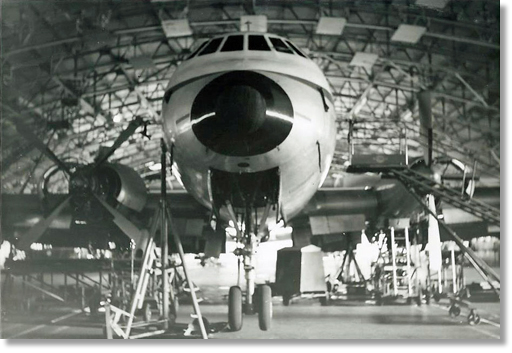
One of the strangest things I ever encountered with the old Brit was strangely a Canadian CL44, I believe it was called (you plane spotters may correct me). It was at the time when Canada was ferrying UN Troops to Cyprus to reinforce the UN during a particularly serious breakdown of talks between the Turks and the Greeks. The word had filtered down to me, the lowly storeman, that this aircraft had diverted into Lyneham as their number two engine had a fault and they had shut it down for safety reasons and diverted. As the aircraft was identical to our Brits, a space was made in J3 hangar and the said aircraft was carefully backed in. On my way to breakfast I thought I would go and see what all the fuss was about and there it was under the lights exactly the same but with red markings, it was amazing how similar they were.
I must have looked at it for a few minutes when one of our engine fitters asked if I knew what was wrong with the aircraft, I of course said I had no idea and he said go and look at the No 2 propeller, and this is God's honest truth, the tip on one blade was bent forwards, gob smacked I asked him what could do that? The crew had said that they were overtaken by a small fiery ball very close to them and extremely fast, and soon after the problems started with the engine and the shutdown was instigated.
I must have looked at it for a few minutes when one of our engine fitters asked if I knew what was wrong with the aircraft, I of course said I had no idea and he said go and look at the No 2 propeller, and this is God's honest truth, the tip on one blade was bent forwards, gob smacked I asked him what could do that? The crew had said that they were overtaken by a small fiery ball very close to them and extremely fast, and soon after the problems started with the engine and the shutdown was instigated.
Now, I can't corroborate this but I can assure you that this is the only time I ever saw a propeller blade bent forward on any aircraft. If you look closely at the picture above you can see it on the right side. Is that spooky or what?
Anyway, it was some time later I was introduced to the wonderful life in belly holds and freight door guards which resembled a giant banana, what a wonderful life it became.
Best wishes to all
KP
Anyway, it was some time later I was introduced to the wonderful life in belly holds and freight door guards which resembled a giant banana, what a wonderful life it became.
Best wishes to all
KP

From: Barry Tappenden, Shortstown, Beds
Subject: Memories of the Whispering Giant
Go back to the time I was in the Far East with FEAF MAMS and was detached to RAF Gan to "help out"? British Eagle were trooping between the UK and Australia using a Britannia. Two things spring to mind on their return flight from Australia:
Firstly: The crew always brought fresh milk - not the usual powdered stuff.
Secondly: I had to take the female crew members to the mess for food. I took them in a mini van which had only one seat. Somehow we managed to squeeze both of them into the front. Changing gear was a challenge and I did get a few "green eyed" stares from the lads!
Best regards
Barry Tappenden
Subject: Memories of the Whispering Giant
Go back to the time I was in the Far East with FEAF MAMS and was detached to RAF Gan to "help out"? British Eagle were trooping between the UK and Australia using a Britannia. Two things spring to mind on their return flight from Australia:
Firstly: The crew always brought fresh milk - not the usual powdered stuff.
Secondly: I had to take the female crew members to the mess for food. I took them in a mini van which had only one seat. Somehow we managed to squeeze both of them into the front. Changing gear was a challenge and I did get a few "green eyed" stares from the lads!
Best regards
Barry Tappenden

From: Graham Cotton, Peterborough, Northants
Subject: Whispering Giant
Hi Tony,
My first Britannia flight was in 1961 from Singapore to the UK and it took 23 hours. It was a civil charter I think. My first Brit flight while in the RAF was from Lyneham to Akrotiri on a posting to Cyprus in ‘67.
I did 2 years, 1970-72, on Britannia role equipment working on the whole fleet and travelling whilst there to numerous locations recovering role equipment.
I was posted to Masirah 1972-73. The worst time I had there was when Britannia's XM637 and XM638 were on the pan at the same time. OC Catering, who did not like the Movers, was tourex and I inadvertently put his baggage on the wrong a/c and it ended up in Brunei! Got a bollocking from either John Illsley or Terry Titterington, I can't recall who now, but hey-ho, simple mistake!
My last Britannia flight was homeward bound from Masirah when I was tourex in '73.
Regards
Graham Cotton
Subject: Whispering Giant
Hi Tony,
My first Britannia flight was in 1961 from Singapore to the UK and it took 23 hours. It was a civil charter I think. My first Brit flight while in the RAF was from Lyneham to Akrotiri on a posting to Cyprus in ‘67.
I did 2 years, 1970-72, on Britannia role equipment working on the whole fleet and travelling whilst there to numerous locations recovering role equipment.
I was posted to Masirah 1972-73. The worst time I had there was when Britannia's XM637 and XM638 were on the pan at the same time. OC Catering, who did not like the Movers, was tourex and I inadvertently put his baggage on the wrong a/c and it ended up in Brunei! Got a bollocking from either John Illsley or Terry Titterington, I can't recall who now, but hey-ho, simple mistake!
My last Britannia flight was homeward bound from Masirah when I was tourex in '73.
Regards
Graham Cotton

From: Fred Martin, Godalming, Surrey
Subject: Memories of the Whispering Giant
My first memory was in August 1961 when I flew out to my first posting, Khormaksar, on a British United Airways Britannia. I was an 18 year old AC2 just out of Movements School at Kidbrooke. I had never flown before and it was obviously an unforgettable experience.
During the next two years I was to get to know the Britannia very well indeed! I spent most of my time at Khormaksar Air Movements in the Load Control section and completed many trim sheets for the Lyneham based 511 and 99 Squadron Brits as they staged through Aden.
I wangled a second trip home on leave (I had been home on Lukfree* some months earlier) as an Indulgence passenger on a freighter with only about 6 passengers on board.
That particular flight, in early 1963, was piloted by the CO at Lyneham. I cannot remember his name but do remember that he was a really nice guy and invited me to sit in the cockpit as we approached the outskirts of Egypt. Military aircraft were not allowed to overfly Egypt at the time and I remember him telling me that we were over Sudan just approaching "Nasser's Corner" the bit of Egypt that juts out where Sudan and Egypt meet.
In late 1962 I joined an eastbound 99 Squadron Britannia at Khormaksar for a duty trip out to Changi. The crew had asked for a volunteer from Air Movementss to assist the AQM as the Brunei crisis had flared up and they were carrying extra troops and freight. I had a couple of days off, so I volunteered (the only time I ever volunteered for anything) and went. The flight was taken off the slip and sent to Labuan in Borneo. I spent an interesting short time there before returning to Changi and then back to Aden.
The last time I flew on a Britannia was again a BUA one as it took me back to the UK when I became tourex at the end my two years. That was probably one of the best flights I have ever had as I watched the lights of Aden vanish below and the thoughts that I would probably never have to go back to that hell hole again, and fortunately I didn't :)
*Lukfree - stands for “Leave UK Free” and could be taken once 45% of a tour had been completed.
Subject: Memories of the Whispering Giant
My first memory was in August 1961 when I flew out to my first posting, Khormaksar, on a British United Airways Britannia. I was an 18 year old AC2 just out of Movements School at Kidbrooke. I had never flown before and it was obviously an unforgettable experience.
During the next two years I was to get to know the Britannia very well indeed! I spent most of my time at Khormaksar Air Movements in the Load Control section and completed many trim sheets for the Lyneham based 511 and 99 Squadron Brits as they staged through Aden.
I wangled a second trip home on leave (I had been home on Lukfree* some months earlier) as an Indulgence passenger on a freighter with only about 6 passengers on board.
That particular flight, in early 1963, was piloted by the CO at Lyneham. I cannot remember his name but do remember that he was a really nice guy and invited me to sit in the cockpit as we approached the outskirts of Egypt. Military aircraft were not allowed to overfly Egypt at the time and I remember him telling me that we were over Sudan just approaching "Nasser's Corner" the bit of Egypt that juts out where Sudan and Egypt meet.
In late 1962 I joined an eastbound 99 Squadron Britannia at Khormaksar for a duty trip out to Changi. The crew had asked for a volunteer from Air Movementss to assist the AQM as the Brunei crisis had flared up and they were carrying extra troops and freight. I had a couple of days off, so I volunteered (the only time I ever volunteered for anything) and went. The flight was taken off the slip and sent to Labuan in Borneo. I spent an interesting short time there before returning to Changi and then back to Aden.
The last time I flew on a Britannia was again a BUA one as it took me back to the UK when I became tourex at the end my two years. That was probably one of the best flights I have ever had as I watched the lights of Aden vanish below and the thoughts that I would probably never have to go back to that hell hole again, and fortunately I didn't :)
*Lukfree - stands for “Leave UK Free” and could be taken once 45% of a tour had been completed.

From: Colin Easdon-Smith, Ingham, QLD
Subject: Memories of the Whispering Giant
Hi Tony,
Yes, I do have a story about the Whispering Giant. After my two and a half year stint in Bahrain, I was returned to the UK for demob in 1960 and waited for the the paperwork to be completed. I had already had an offer from the local newspaper in Bahrain, THE GULF DAILY TIMES, to return in the capacity of Sports and Features journalist.
Shirley, my wife, and son, Ashley, remained in the UK until I got settled on the Island, and I flew out on a Transport Command flight. I enjoyed being back, as I had made quite a few friends, not only in the Arab community but also the Indians.
Unfortunately, politics entered into the local scenes. The ruling royal family were fairly liberal; the Arabs were allowed to drink alcohol as long as they did not make a public nuiscence of themselves. There were Jews amongst the population working and living peacefully with the other nationalities. Persia, now known as Iran, was just across the narrow straights, and for centuries had eyed all the territories in the area; Sharjah, Dubai, Qatar, Muscat and Abu Dhabi were all safe-guarded by a series of treaties with the UK, which kept the Iranians at bay.
(The Middle East initially began to simmer when Israel was founded. The Palestinians, who had lived for centuries on the land, were uprooted and their land given to the Jews who had been displaced by Hitler’s holocaust programs.)
One dreadful night, the newspaper offices were bombed and destroyed. His Highness Sheikh Isa bin Salman made a public statement that the newspaper would not reopen because of the turmoil in the area. So, I found myself without a job, and I was informed by the British Consul that I was being repatriated on the first available aircraft.
It so happened BOAC had a Whispering Giant returning from a delayed schedule flight out of Singapore that had experienced engine problems, and would be calling in to refuel at Bahrain. I was given 10 hours to put my house in order. I tried to see and and say goodbye to all the people I had got to know, including my Taxi driver friend, Mohamed Quanum. He drove me that night to the Airport. He had helped me get to know and understand the Arabs, and their way of life.
The plane landed, taxied in to refuel, the steps lowered, and I climbed aboard. I had the whole passenger cabin to myself, the complete crew welcomed me, and I was told to sit wherever I wanted. Naturally, I chose First Class. Not long and we were airborne on the final leg of my journey back home.
There you have it. I thoroughly enjoyed my Arab experience. I rejoined Lufthansa in the Reservations Department on Regent Street in London and a year later emmigrated to Australia.
Cheers!
Colin
Subject: Memories of the Whispering Giant
Hi Tony,
Yes, I do have a story about the Whispering Giant. After my two and a half year stint in Bahrain, I was returned to the UK for demob in 1960 and waited for the the paperwork to be completed. I had already had an offer from the local newspaper in Bahrain, THE GULF DAILY TIMES, to return in the capacity of Sports and Features journalist.
Shirley, my wife, and son, Ashley, remained in the UK until I got settled on the Island, and I flew out on a Transport Command flight. I enjoyed being back, as I had made quite a few friends, not only in the Arab community but also the Indians.
Unfortunately, politics entered into the local scenes. The ruling royal family were fairly liberal; the Arabs were allowed to drink alcohol as long as they did not make a public nuiscence of themselves. There were Jews amongst the population working and living peacefully with the other nationalities. Persia, now known as Iran, was just across the narrow straights, and for centuries had eyed all the territories in the area; Sharjah, Dubai, Qatar, Muscat and Abu Dhabi were all safe-guarded by a series of treaties with the UK, which kept the Iranians at bay.
(The Middle East initially began to simmer when Israel was founded. The Palestinians, who had lived for centuries on the land, were uprooted and their land given to the Jews who had been displaced by Hitler’s holocaust programs.)
One dreadful night, the newspaper offices were bombed and destroyed. His Highness Sheikh Isa bin Salman made a public statement that the newspaper would not reopen because of the turmoil in the area. So, I found myself without a job, and I was informed by the British Consul that I was being repatriated on the first available aircraft.
It so happened BOAC had a Whispering Giant returning from a delayed schedule flight out of Singapore that had experienced engine problems, and would be calling in to refuel at Bahrain. I was given 10 hours to put my house in order. I tried to see and and say goodbye to all the people I had got to know, including my Taxi driver friend, Mohamed Quanum. He drove me that night to the Airport. He had helped me get to know and understand the Arabs, and their way of life.
The plane landed, taxied in to refuel, the steps lowered, and I climbed aboard. I had the whole passenger cabin to myself, the complete crew welcomed me, and I was told to sit wherever I wanted. Naturally, I chose First Class. Not long and we were airborne on the final leg of my journey back home.
There you have it. I thoroughly enjoyed my Arab experience. I rejoined Lufthansa in the Reservations Department on Regent Street in London and a year later emmigrated to Australia.
Cheers!
Colin

From: Gordon Gray, Allestree, Derby
Subject: Memories of the 'Whispering Giant'
90% of our staging ‘Brits’ thru’ Gan in 1964/5 were PCF in 18 seat fit and often flat floor. Any aero engine by way of Proteus, Avon, Griffon or a Britannia prop destined for us it would be palletised. But, remember the BFLP (Britannia Freight Lift Platform), we had one and only TASF used it occasionally to assist with aircraft engine changes as it was a time wasting pain to use.
Staging ‘Brits’ and Comets were on quick turnrounds and a 10k Henly FLT was the usual ACHE used. My only formal use of a BFLP was on No 2 Junior Air Movements Course at RAF Abingdon in 1964. Thank goodness I never used one ‘in anger’. If memory serves me correctly it was never used for aircraft handling on Gan in my 12 months there.
Route movements of ‘Brits’ of 99 and 511 Squadrons out of Lyneham staging through to Changi were daily eastward in the mornings and return westward late evening. Sometimes, trimming the aircraft could be fraught with frustration as with only one of us trim clerks on either of the two shifts, with delayed other schedules staging, we’d be part completing one then chasing across to the other aircraft. I'd never known AQM’s in those days to do their own trim sheets on Gan.
Rule of thumb for trimming a ‘Brit’ was it not, 1/3 and 2/3 on the datum. Any OBA member remember? Do correct me before my memory goes completely.
Talking of Britannia’s, British Eagle's weekly schedules were always welcome on their way to Cocos Island and on to Australia. The Air ‘Stewardesses’ would always be a sight for sore eyes but additionally take orders for fresh milk to be brought back on the return journey through Cocos.
Occasionally we had visits from Canadian Yukon’s but seldom was there any work to do except handle and ration up!
Happy times, thanks Tony!
Gordon
Subject: Memories of the 'Whispering Giant'
90% of our staging ‘Brits’ thru’ Gan in 1964/5 were PCF in 18 seat fit and often flat floor. Any aero engine by way of Proteus, Avon, Griffon or a Britannia prop destined for us it would be palletised. But, remember the BFLP (Britannia Freight Lift Platform), we had one and only TASF used it occasionally to assist with aircraft engine changes as it was a time wasting pain to use.
Staging ‘Brits’ and Comets were on quick turnrounds and a 10k Henly FLT was the usual ACHE used. My only formal use of a BFLP was on No 2 Junior Air Movements Course at RAF Abingdon in 1964. Thank goodness I never used one ‘in anger’. If memory serves me correctly it was never used for aircraft handling on Gan in my 12 months there.
Route movements of ‘Brits’ of 99 and 511 Squadrons out of Lyneham staging through to Changi were daily eastward in the mornings and return westward late evening. Sometimes, trimming the aircraft could be fraught with frustration as with only one of us trim clerks on either of the two shifts, with delayed other schedules staging, we’d be part completing one then chasing across to the other aircraft. I'd never known AQM’s in those days to do their own trim sheets on Gan.
Rule of thumb for trimming a ‘Brit’ was it not, 1/3 and 2/3 on the datum. Any OBA member remember? Do correct me before my memory goes completely.
Talking of Britannia’s, British Eagle's weekly schedules were always welcome on their way to Cocos Island and on to Australia. The Air ‘Stewardesses’ would always be a sight for sore eyes but additionally take orders for fresh milk to be brought back on the return journey through Cocos.
Occasionally we had visits from Canadian Yukon’s but seldom was there any work to do except handle and ration up!
Happy times, thanks Tony!
Gordon
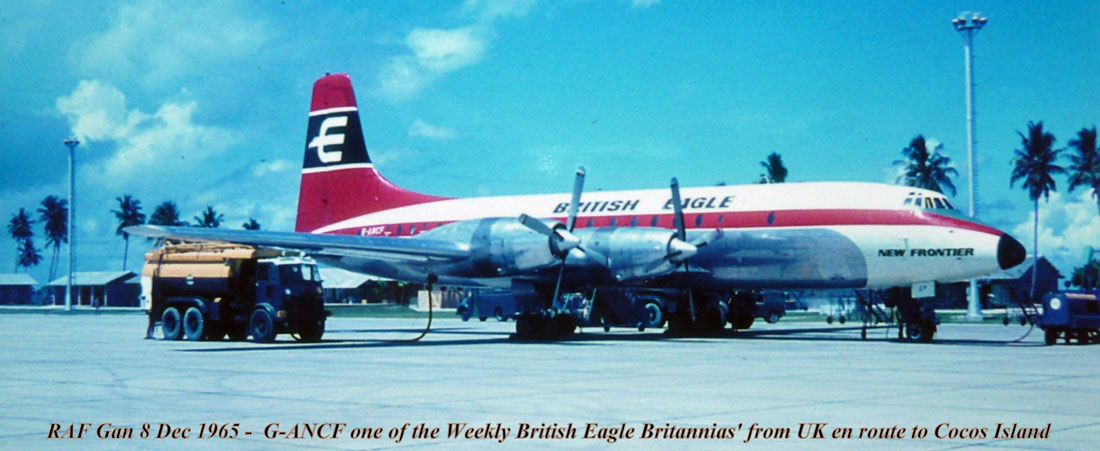

From: Bryan Morgan, Abingdon, Oxon
Subject: Memories of the Whispering Giant
Tony,
I have very fond memories of the Britannia, probably the most beautiful aircraft the RAF has ever flown. The British Eagle variant used for trooping between Heathrow and Singapore was also memorable, but for a different reason - a 32 hour trip through two nights!
The RAF variant was at the height of its service when I was DAMO at RAF Changi on that tour during Confrontation with Indonesia in the mid sixties. It normally operated in the PCF role with only 16 seats and umpteen compartments for freight upstairs and in the belly holds. Two things come to mind. The first is that the Brit turn round was six hours - arriving at 0900 and departing at 1500 with a shift change at 1300. My shift was always done the favour at changeover with the preceding shift declaring, rather smugly, that the offload had been completed! Now we all know that the offload/backload timetable was, and probably still is, 33%/66% of the turn round time so why my predecessor elected to reverse things I shall never know. I failed to convince him over many months and I hope, that if he reads this, there will be pang of conscience!
My second memory is that with only two hours to complete the turn round, we sometimes had a brute of a load which comprised, in the main, eight Whirlwind rotor blades with four loaded on top of four. Unfortunately, they were all in their sea freight boxes and weighed a ton; no one had ever thought they would they would be moved by air. Had we been loading a C130, for example, things would been a lot easier but, with each one around 24 feet in length, getting them round the corner of the Brit freight door was a juggling act of some delicacy coupled with a considerable amount of brute force. It required the whole shift, even down to the trim clerk, to strip off and muck in. I was always lost in admiration of how this task was completed in just two hours. Happy days!
Bryan Morgan
Subject: Memories of the Whispering Giant
Tony,
I have very fond memories of the Britannia, probably the most beautiful aircraft the RAF has ever flown. The British Eagle variant used for trooping between Heathrow and Singapore was also memorable, but for a different reason - a 32 hour trip through two nights!
The RAF variant was at the height of its service when I was DAMO at RAF Changi on that tour during Confrontation with Indonesia in the mid sixties. It normally operated in the PCF role with only 16 seats and umpteen compartments for freight upstairs and in the belly holds. Two things come to mind. The first is that the Brit turn round was six hours - arriving at 0900 and departing at 1500 with a shift change at 1300. My shift was always done the favour at changeover with the preceding shift declaring, rather smugly, that the offload had been completed! Now we all know that the offload/backload timetable was, and probably still is, 33%/66% of the turn round time so why my predecessor elected to reverse things I shall never know. I failed to convince him over many months and I hope, that if he reads this, there will be pang of conscience!
My second memory is that with only two hours to complete the turn round, we sometimes had a brute of a load which comprised, in the main, eight Whirlwind rotor blades with four loaded on top of four. Unfortunately, they were all in their sea freight boxes and weighed a ton; no one had ever thought they would they would be moved by air. Had we been loading a C130, for example, things would been a lot easier but, with each one around 24 feet in length, getting them round the corner of the Brit freight door was a juggling act of some delicacy coupled with a considerable amount of brute force. It required the whole shift, even down to the trim clerk, to strip off and muck in. I was always lost in admiration of how this task was completed in just two hours. Happy days!
Bryan Morgan

From: Syd Avery, Guardamar del Segura
Subject: Bristol Britannia.
Hi, Tony et al,
Loved the Brit. Had nothing dramatic happen whenever I worked with them. My stint in KTM on the BRIGLOC with them taught me a lot about the operational side of plane playing which was of great use in later life.
My first flight on a Brit was on posting to Changi on 5th January 1965. The route was LHR-IST-BOM-SIN, by British Eagle.
Whilst working for African International in Rome, we were light swinging at a post trip wind down and I mentioned this to my Captain, "Champagne" Jack Randles. "Interesting." Says he.
Next time I saw him, he showed me one of his old log books. On 6th January 1965, he had been the First Officer on the IST-BOM leg of my flight!
Muchas gracias Señor Antonio.
Mudguards, Syd.
Subject: Bristol Britannia.
Hi, Tony et al,
Loved the Brit. Had nothing dramatic happen whenever I worked with them. My stint in KTM on the BRIGLOC with them taught me a lot about the operational side of plane playing which was of great use in later life.
My first flight on a Brit was on posting to Changi on 5th January 1965. The route was LHR-IST-BOM-SIN, by British Eagle.
Whilst working for African International in Rome, we were light swinging at a post trip wind down and I mentioned this to my Captain, "Champagne" Jack Randles. "Interesting." Says he.
Next time I saw him, he showed me one of his old log books. On 6th January 1965, he had been the First Officer on the IST-BOM leg of my flight!
Muchas gracias Señor Antonio.
Mudguards, Syd.

Canadair CC-106 Yukon & CL-44 "Swing-Tail" Promo Spot - 1960

From: Allan Walker, Burnley, Lancashire
Subject: Memories of the Whispering Giant
Hi Tony,
Whilst at RAF El Adem in the early 1960’s I witnessed my first Britannia taxying onto a busy dispersal. Amazement as it then started to reverse back into an empty slot.
As Duty Mover one Sunday morning, I had a call from the tower saying that an IL18 was on finals. As we had the Americans flying spotter aircraft L19 Birddogs, I arrived at the dispersal with my shift NCO in a Landover expecting to pick up one pilot. To my horror I watched what I thought was a Britannia with strange markings landing. On arrival at the dispersal it turned out to be a Russian IL18 (Copy of the Britannia). Steps up to await an open door to be met with a Ghanaian hostess who announced that she had 6 passengers for me. I advised her that I thought that she was mistaken as this was a military airfield, she replied, “Is this not Cairo?”.
The story goes that the aircraft was operated with a Russian Flight crew and they had not advised the Ghanaian Cabin Crew of a flight change. They had been due to land at Cairo but the Flight crew has misread their NOTAMs which stated that Cairo would be closed and diverted the flight to Benghazi, a civil airport to the east of EL Adem.
The crew advised that on their way to Benghazi they had to divert into El Adem as they had an engine failure. With a full passenger load, the arrangements had to be made to accommodate them. As it turned out this was for over a week. This caused a great number of problems as they were not allowed to leave the airfield. Also they were confined to the transit area only. A spare engine was flown in and with the help of RAF ground crew was duly changed. When they asked if there was any documentation they were given a full set, however this was in Russian. Eventually the aircraft took off but not before the flight crew, who were discussing something in Russian, were astonished to be answered in Russian by one of our Air Traffic Controllers, Master Aircrew Gabrowski, in their mother tongue.
To this day I still wonder about that flight because it turned up in the middle of a large military exercise involving Hunter, Canberra and Javelin aircraft and left on the last day of the exercise.
The “Whispering Giant” was a great aircraft but not the dreaded BFLP needed to load and unload!
Yours aye
Allan
Subject: Memories of the Whispering Giant
Hi Tony,
Whilst at RAF El Adem in the early 1960’s I witnessed my first Britannia taxying onto a busy dispersal. Amazement as it then started to reverse back into an empty slot.
As Duty Mover one Sunday morning, I had a call from the tower saying that an IL18 was on finals. As we had the Americans flying spotter aircraft L19 Birddogs, I arrived at the dispersal with my shift NCO in a Landover expecting to pick up one pilot. To my horror I watched what I thought was a Britannia with strange markings landing. On arrival at the dispersal it turned out to be a Russian IL18 (Copy of the Britannia). Steps up to await an open door to be met with a Ghanaian hostess who announced that she had 6 passengers for me. I advised her that I thought that she was mistaken as this was a military airfield, she replied, “Is this not Cairo?”.
The story goes that the aircraft was operated with a Russian Flight crew and they had not advised the Ghanaian Cabin Crew of a flight change. They had been due to land at Cairo but the Flight crew has misread their NOTAMs which stated that Cairo would be closed and diverted the flight to Benghazi, a civil airport to the east of EL Adem.
The crew advised that on their way to Benghazi they had to divert into El Adem as they had an engine failure. With a full passenger load, the arrangements had to be made to accommodate them. As it turned out this was for over a week. This caused a great number of problems as they were not allowed to leave the airfield. Also they were confined to the transit area only. A spare engine was flown in and with the help of RAF ground crew was duly changed. When they asked if there was any documentation they were given a full set, however this was in Russian. Eventually the aircraft took off but not before the flight crew, who were discussing something in Russian, were astonished to be answered in Russian by one of our Air Traffic Controllers, Master Aircrew Gabrowski, in their mother tongue.
To this day I still wonder about that flight because it turned up in the middle of a large military exercise involving Hunter, Canberra and Javelin aircraft and left on the last day of the exercise.
The “Whispering Giant” was a great aircraft but not the dreaded BFLP needed to load and unload!
Yours aye
Allan

From: Neil Collie, Canberra, ACT
Subject: Changi and Britannia
Enjoyed the Henry Probert Changi article Tony. Taken from Henry Probert’s excellent ‘History of Changi’ ISBN 981-05-5580-6 I think. I bought my Old Man (A Cpl Blacksmith in Station Workshops - now deceased) a copy a few years back and used the old station map in the book a number of years ago to navigate my way to the hospital where I was born on a visit to Singapore. The Station Church where I was christened is still in use and the pews, font and so on etc., are original. We were there on a Sunday and the congregation were brilliant, especially when I told them that I was Christened there. They insisted that I sign the visitor’s book and have an awesome lunch.
I came home in 1965 by the Britannia Service when my Dad was posted to Binbrook. So my first experience of air travel was courtesy of RAF Movers. We bounced through a number of places on our way to Brize. I think that it must have stuck in my young infant mind and I became one of the ‘elite’ that are the RAF Movers 24 years later. RAF Changi is now a RSAF Base, but the Singaporean guys with whom it is my pleasure to exercise with in my current RAAF life still love the place and love it when I tell them that ‘I’m a Changi Boy’!
Cheers
Neil Collie
Subject: Changi and Britannia
Enjoyed the Henry Probert Changi article Tony. Taken from Henry Probert’s excellent ‘History of Changi’ ISBN 981-05-5580-6 I think. I bought my Old Man (A Cpl Blacksmith in Station Workshops - now deceased) a copy a few years back and used the old station map in the book a number of years ago to navigate my way to the hospital where I was born on a visit to Singapore. The Station Church where I was christened is still in use and the pews, font and so on etc., are original. We were there on a Sunday and the congregation were brilliant, especially when I told them that I was Christened there. They insisted that I sign the visitor’s book and have an awesome lunch.
I came home in 1965 by the Britannia Service when my Dad was posted to Binbrook. So my first experience of air travel was courtesy of RAF Movers. We bounced through a number of places on our way to Brize. I think that it must have stuck in my young infant mind and I became one of the ‘elite’ that are the RAF Movers 24 years later. RAF Changi is now a RSAF Base, but the Singaporean guys with whom it is my pleasure to exercise with in my current RAAF life still love the place and love it when I tell them that ‘I’m a Changi Boy’!
Cheers
Neil Collie

From: Gerry Davis, Bedminster
Subject: Malcolm Porter.
Over the Christmas period, an old Air Mover friend of mine, Malcolm Porter, passed away. He was referred to by many as ‘SWINGTAIL’ A name he got when he was a loadmaster on CL-44s. We served together on NEAF MAMS in the 60’s. He was then an SAC.
Malcolm had a very interesting career, as I understand it he served twice in the RAF. He also served in the Rhodesian Air Force as a loadmaster on their CL-44, until it was blown up in a hangar whilst being serviced. Sabotage was suspected, and this incident resulted in his service contract being terminated. He had a few tales to tell of sanction busting whilst crewing on this aircraft and when airborne he recalled being chased by jets of an African Air Force. He was also contracted to a Libyan charter airline for a period. He was involved with other air charter airlines too and was a crew member of the last CL-44 which landed at Bournemouth Airport and now lays abandoned.
We used to meet up now and again, that was until his health caught up with him. He took great pride in being the president of the CL44 Association and organised their yearly meetings at the officer’s club in London where aircrews, engineers and others met for a chinwag and get-together.
He was the co-author of a pictorial book about the CL44’s. I often asked him to write a book of his memoirs and gave him advice as to what to put in it and what format to use. Alas, this did not come to fruition. This would have been a very interesting account of his many experiences.
This picture is of Malcolm, Brian Kent and myself, taken at the former RAF Kemble in the AV8 Restaurant, October, 2011.
Rest in peace Malcolm.
Subject: Malcolm Porter.
Over the Christmas period, an old Air Mover friend of mine, Malcolm Porter, passed away. He was referred to by many as ‘SWINGTAIL’ A name he got when he was a loadmaster on CL-44s. We served together on NEAF MAMS in the 60’s. He was then an SAC.
Malcolm had a very interesting career, as I understand it he served twice in the RAF. He also served in the Rhodesian Air Force as a loadmaster on their CL-44, until it was blown up in a hangar whilst being serviced. Sabotage was suspected, and this incident resulted in his service contract being terminated. He had a few tales to tell of sanction busting whilst crewing on this aircraft and when airborne he recalled being chased by jets of an African Air Force. He was also contracted to a Libyan charter airline for a period. He was involved with other air charter airlines too and was a crew member of the last CL-44 which landed at Bournemouth Airport and now lays abandoned.
We used to meet up now and again, that was until his health caught up with him. He took great pride in being the president of the CL44 Association and organised their yearly meetings at the officer’s club in London where aircrews, engineers and others met for a chinwag and get-together.
He was the co-author of a pictorial book about the CL44’s. I often asked him to write a book of his memoirs and gave him advice as to what to put in it and what format to use. Alas, this did not come to fruition. This would have been a very interesting account of his many experiences.
This picture is of Malcolm, Brian Kent and myself, taken at the former RAF Kemble in the AV8 Restaurant, October, 2011.
Rest in peace Malcolm.
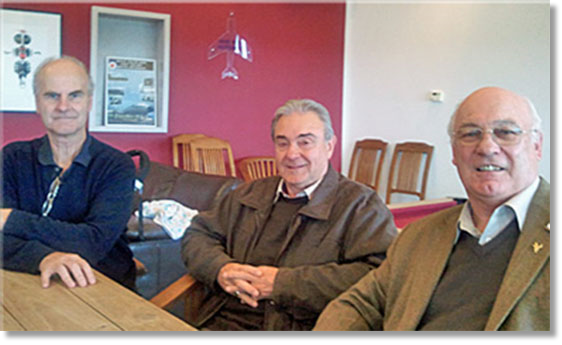
Rhodesia - From the Oil Lift to a Scary Flight Story!
By the late Malcolm Porter (first published in the OBA Briefs January 2012)
By the late Malcolm Porter (first published in the OBA Briefs January 2012)
When I was a part of NEAF MAMS and I found myself in Nairobi loading what seemed to be an endless 'ramp' of Britannia's both RAF and civil, I became intrigued with Rhodesia; a small newly-formed independent African country that had declared UDI (Unilateral Declaration of Independence) under its new Prime Minister, Ian Smith.
At the end of my RAF service I had been taken on as a Loadmaster by Trans Meridian Air Cargo in Stansted, but Rhodesia was always at the forefront of my mind and gave rise to more and more interest. It was difficult to gain any information other than from daily newspaper reports, so gradually the idea of obtaining more knowledge was shelved.
We had just completed a particularly nasty cattle charter which meant that we odorous crew members were not allowed into Ops and I wasn't feeling too happy about my situation. It was at that time that I happened across a cunningly disguised job advertisement in an edition of Flight Magazine asking for all aircrew types to apply to South Africa House in London. My letter of enquiry to South Africa House produced a response and confirmed that the advert had been placed on behalf of a neighbouring country. Visits to London eventually revealed that it was the Rhodesian Air Force that would be the employer and it took very little time for me to say Yes!
I was informed that the transport fleet consisted of six or seven DC3's (3 Sqdn) but that an Air Movements Unit was to be set up. Currently, passenger handling and cargo loading was being undertaken by personnel from Air Rhodesia and a few members of a newly-formed Volunteer Reserve Squadron.
Travel to Salisbury was by a South African Airways scheduled flight with the destination clearly shown on my ticket as Johannesburg. My arrival at Salisbury provided an introduction to the Rhodesian Air Force's Recruitment Section - one Sgt John Le Page, an Australian who ran the entire recruitment effort on his own!
A build-up in cross-border raids had resulted in additional flights being mounted to the various Forward Air Fields (FAF’s) that the DC-3’s were required to fly into.
It should be noted that many of the air crews were themselves part-time volunteers simply doing their bit.
Passenger flights were increased and flew almost daily schedules. Over-the-border work did not involve us, this being done by the Paras of Selous Scouts. Across the runway at Salisbury was the legendary Air Trans Africa and its charismatic Managing Director, Cap'n Jack Malloch. Jack had flown Spitfires for the RAF in WWII and had also been heavily involved in the Biafran Affair - indeed he and his crew had been imprisoned by the Nigerians when his DC7 had been found to contain Arms and Ammunition bound for the Biafrans.
Eventually, OC 3 Squadron approached me and summilarily invited me and my wife to dinner, to be held that evening at Jack's house. Over dinner I was told that I had been 'bought out' of the Rhodesian Air Force and was to join the ranks of the airline known collectively as Air Trans Africa, Affretair, CargOman and Air Gabon Cargo whose entire fleet consisted of 1 CL44-D4 and 2 DC8-55's.
At the end of my RAF service I had been taken on as a Loadmaster by Trans Meridian Air Cargo in Stansted, but Rhodesia was always at the forefront of my mind and gave rise to more and more interest. It was difficult to gain any information other than from daily newspaper reports, so gradually the idea of obtaining more knowledge was shelved.
We had just completed a particularly nasty cattle charter which meant that we odorous crew members were not allowed into Ops and I wasn't feeling too happy about my situation. It was at that time that I happened across a cunningly disguised job advertisement in an edition of Flight Magazine asking for all aircrew types to apply to South Africa House in London. My letter of enquiry to South Africa House produced a response and confirmed that the advert had been placed on behalf of a neighbouring country. Visits to London eventually revealed that it was the Rhodesian Air Force that would be the employer and it took very little time for me to say Yes!
I was informed that the transport fleet consisted of six or seven DC3's (3 Sqdn) but that an Air Movements Unit was to be set up. Currently, passenger handling and cargo loading was being undertaken by personnel from Air Rhodesia and a few members of a newly-formed Volunteer Reserve Squadron.
Travel to Salisbury was by a South African Airways scheduled flight with the destination clearly shown on my ticket as Johannesburg. My arrival at Salisbury provided an introduction to the Rhodesian Air Force's Recruitment Section - one Sgt John Le Page, an Australian who ran the entire recruitment effort on his own!
A build-up in cross-border raids had resulted in additional flights being mounted to the various Forward Air Fields (FAF’s) that the DC-3’s were required to fly into.
It should be noted that many of the air crews were themselves part-time volunteers simply doing their bit.
Passenger flights were increased and flew almost daily schedules. Over-the-border work did not involve us, this being done by the Paras of Selous Scouts. Across the runway at Salisbury was the legendary Air Trans Africa and its charismatic Managing Director, Cap'n Jack Malloch. Jack had flown Spitfires for the RAF in WWII and had also been heavily involved in the Biafran Affair - indeed he and his crew had been imprisoned by the Nigerians when his DC7 had been found to contain Arms and Ammunition bound for the Biafrans.
Eventually, OC 3 Squadron approached me and summilarily invited me and my wife to dinner, to be held that evening at Jack's house. Over dinner I was told that I had been 'bought out' of the Rhodesian Air Force and was to join the ranks of the airline known collectively as Air Trans Africa, Affretair, CargOman and Air Gabon Cargo whose entire fleet consisted of 1 CL44-D4 and 2 DC8-55's.
Then began probably the biggest adventure anyone would want to be a part of. The move across the runway at New Sarum was completed at the 'speed of heat' and within days I was at the offices of ATA being introduced to the ways and wherefores of operating (mainly illegally), the CL44 and DC8's.
The following week or two involved similar flights in both the CL44 and DC8 to exotic destinations such as Port Gentil, Doala and Kinshasa where the priority was always to ensure that the cargo was offloaded onto the official transport (there had been an occasion when 'pirates' had turned up and taken 22 tonnes of meat from the CL44 in Nairobi!).
A security meeting at Salisbury came prior to a flight on board a DC8 from Douala to Muscat where the aircraft was loaded with Hunter aircraft parts for the Rhodesian Air Force - Then it was the direct flight back to Salisbury. Thereafter, the whole of 1977 and '78 continued much in the same maner with further destinations including Larnaca, Las Palmas and Basel.
There were only two other Loadmasters at Salisbury besides myself and we were kept very busy. Londoner Christopher Stanley-Knaggs (known as Snags) and a South American, 'Catcho' Cabral who was the chief wheeler/dealer for anything down route. Holidays could be taken to the UK with free seats on board the DC8's to Amsterdam and many a flight held 18 SNC in the 'back'.
Then on May 24th 1978, the routine was interrupted. The normal sequence of events for most flights was for Operations to call the 4 members of the crew two hours before scheduled departure with the Loadmaster getting a little time extra to arrive in time to look at the load in the hangar, work out a load sheet before receiving any fuel figures, then to commence loading as the other three arrived.
One important duty of the Loadie was to make sure that the home-made food was on board; Jack had the most wonderful inflight kitchen producing some great meals.
Our destination on this morning was Port Gentil in Gabon and the load was the normal fresh Rhodesian fruit and veg. The crew was well known to me; Tom Phillips was an unflappable captain, been around a long time and we had flown together many time.
First Officer was John Murphy, a young Irish guy - a rogue of a character but extremely professional. Lastly there was the Flight Engineer, Les Martin - another 'old timer' and a lover of the CL44. Take offs were at 04:00 so that the outside air temperature was relatively low and there were few prying eyes about.
The CL44 was Gabonese registered and a regular traveller around Africa. It was well known that most knew exactly who did operate the aircraft but flight plans were legal - all members of the crew, could if they wished, view the flight plan, though seldom ever did.
Bills of Lading were meticulously presented and once all the normal pre-flight activity had been completed and the crew door closed, start-up would commence. My 'day' would consist of the flight to 'Pog', the safe offload, then the short flight to Libreville where the CL44 would take on fuel for the return empty leg to Salisbury. I would leave the aircraft at Libreville and transfer to the DC8 for the regular flight to Amsterdam where a charter load would take us to Seeb in Oman. These loads would normally be general cargo whilst loads outbound from Seeb would sometimes be military equipment for Salisbury. It was normal for a Loadmaster to spend 4 or 5 nights away from home.
The following week or two involved similar flights in both the CL44 and DC8 to exotic destinations such as Port Gentil, Doala and Kinshasa where the priority was always to ensure that the cargo was offloaded onto the official transport (there had been an occasion when 'pirates' had turned up and taken 22 tonnes of meat from the CL44 in Nairobi!).
A security meeting at Salisbury came prior to a flight on board a DC8 from Douala to Muscat where the aircraft was loaded with Hunter aircraft parts for the Rhodesian Air Force - Then it was the direct flight back to Salisbury. Thereafter, the whole of 1977 and '78 continued much in the same maner with further destinations including Larnaca, Las Palmas and Basel.
There were only two other Loadmasters at Salisbury besides myself and we were kept very busy. Londoner Christopher Stanley-Knaggs (known as Snags) and a South American, 'Catcho' Cabral who was the chief wheeler/dealer for anything down route. Holidays could be taken to the UK with free seats on board the DC8's to Amsterdam and many a flight held 18 SNC in the 'back'.
Then on May 24th 1978, the routine was interrupted. The normal sequence of events for most flights was for Operations to call the 4 members of the crew two hours before scheduled departure with the Loadmaster getting a little time extra to arrive in time to look at the load in the hangar, work out a load sheet before receiving any fuel figures, then to commence loading as the other three arrived.
One important duty of the Loadie was to make sure that the home-made food was on board; Jack had the most wonderful inflight kitchen producing some great meals.
Our destination on this morning was Port Gentil in Gabon and the load was the normal fresh Rhodesian fruit and veg. The crew was well known to me; Tom Phillips was an unflappable captain, been around a long time and we had flown together many time.
First Officer was John Murphy, a young Irish guy - a rogue of a character but extremely professional. Lastly there was the Flight Engineer, Les Martin - another 'old timer' and a lover of the CL44. Take offs were at 04:00 so that the outside air temperature was relatively low and there were few prying eyes about.
The CL44 was Gabonese registered and a regular traveller around Africa. It was well known that most knew exactly who did operate the aircraft but flight plans were legal - all members of the crew, could if they wished, view the flight plan, though seldom ever did.
Bills of Lading were meticulously presented and once all the normal pre-flight activity had been completed and the crew door closed, start-up would commence. My 'day' would consist of the flight to 'Pog', the safe offload, then the short flight to Libreville where the CL44 would take on fuel for the return empty leg to Salisbury. I would leave the aircraft at Libreville and transfer to the DC8 for the regular flight to Amsterdam where a charter load would take us to Seeb in Oman. These loads would normally be general cargo whilst loads outbound from Seeb would sometimes be military equipment for Salisbury. It was normal for a Loadmaster to spend 4 or 5 nights away from home.
The route this particular morning did involve something of a 'short cut' although this had been flown on many a previous occasion. We were aware that the Angolan Air Force, having been equipped with Russian MiG fighters, could at any time, pay us a visit en route, but to date, had not done so.
About an hour out of Salisbury, John Murphy beckoned me to look out of the flight deck window and I was alarmed to see three MiG 21's criss-crossing. Tom Phillips also mentioned that it was probable that a fourth MiG was on our tail, from where his missiles would lock onto our engine exhausts.
Of course, activity within the cockpit was intense by this time. Tom Phillips had rocked the wings of the CL44 to show his intention to comply and turned west towards Nova Lisboa, losing height as he did so. John Murphy meanwhile had established radio communications with Salisbury who in turn had already spoken with the Gabonese Government. This was to notify the Angolans that they were intercepting a Gabonese aircraft.
Radio communications with Pretoria produced some ill-judged information: It was stated quite clearly by the South Africans that they had intelligence that the MiG's would be unarmed. The moment this was announced, the firing of one of the MiG's missiles confirmed the South Africans were wrong!
Tom Phillips now began to show his ability to remain calm in what was becoming an extremely tense time. Continued use of the forty-four's power lever saw the four Rolls Royce Tynes progressively decreasing the speed of the aircraft whilst continuing a slow descent towards Nova Lisboa; Tom had noticed a build-up of cloud there.
Meanwhile, the three of us were busily employed - I being consigned to the flight crew toilet there to set fire (despite the NO SMOKING signs) to all of the paperwork that could have elicited some awkward questions.
Then the command decision by Tom Phillips, "We are going to make a run for it lads!" We were almost immediately immersed in the thick cloud cover and could hear the level of r/t chatter from the MiG's intensify as they lost us. We flew for the coast and once we had reached the sea turned south-west. About 300 nautical miles later we turned south east and made for Windhoek. When we landed we were almost totally out of fuel.
To complete the day, we were asked by South African Intelligence Officers why we had not seen any registration marks on the MiG's. My reply was that I was far too busy putting my bicycle clips on.
I have to mention here that the following day the same aircraft flew the same route without hindrance, no doubt following some diplomatic dialogue!
My experiences in Rhodesia and subsequent career were made possible due to the training I had received while in the RAF and I must thank my original instructors at Kidbrooke, Flt Sgt's Waltham and Stone - I am eternally grateful!
About an hour out of Salisbury, John Murphy beckoned me to look out of the flight deck window and I was alarmed to see three MiG 21's criss-crossing. Tom Phillips also mentioned that it was probable that a fourth MiG was on our tail, from where his missiles would lock onto our engine exhausts.
Of course, activity within the cockpit was intense by this time. Tom Phillips had rocked the wings of the CL44 to show his intention to comply and turned west towards Nova Lisboa, losing height as he did so. John Murphy meanwhile had established radio communications with Salisbury who in turn had already spoken with the Gabonese Government. This was to notify the Angolans that they were intercepting a Gabonese aircraft.
Radio communications with Pretoria produced some ill-judged information: It was stated quite clearly by the South Africans that they had intelligence that the MiG's would be unarmed. The moment this was announced, the firing of one of the MiG's missiles confirmed the South Africans were wrong!
Tom Phillips now began to show his ability to remain calm in what was becoming an extremely tense time. Continued use of the forty-four's power lever saw the four Rolls Royce Tynes progressively decreasing the speed of the aircraft whilst continuing a slow descent towards Nova Lisboa; Tom had noticed a build-up of cloud there.
Meanwhile, the three of us were busily employed - I being consigned to the flight crew toilet there to set fire (despite the NO SMOKING signs) to all of the paperwork that could have elicited some awkward questions.
Then the command decision by Tom Phillips, "We are going to make a run for it lads!" We were almost immediately immersed in the thick cloud cover and could hear the level of r/t chatter from the MiG's intensify as they lost us. We flew for the coast and once we had reached the sea turned south-west. About 300 nautical miles later we turned south east and made for Windhoek. When we landed we were almost totally out of fuel.
To complete the day, we were asked by South African Intelligence Officers why we had not seen any registration marks on the MiG's. My reply was that I was far too busy putting my bicycle clips on.
I have to mention here that the following day the same aircraft flew the same route without hindrance, no doubt following some diplomatic dialogue!
My experiences in Rhodesia and subsequent career were made possible due to the training I had received while in the RAF and I must thank my original instructors at Kidbrooke, Flt Sgt's Waltham and Stone - I am eternally grateful!

A new member who has joined us recently is:
Lloyd Bradshaw, Brisbane, QLD
Welcome to the OBA!

From: Keith Parker, Bowerhill, Wilts
Subject: Filmed at RAF Marham...
This is brilliant, can you get it on the OBA please Tony?
Best regards,
Keith
Subject: Filmed at RAF Marham...
This is brilliant, can you get it on the OBA please Tony?
Best regards,
Keith

With the sad passing of Windsor Davies [Actor - revered for his role in "It Ain't Half Hot Mum!"], I thought it appropriate to share one of his lesser-known works.
This RAF training film has Windsor, in full Army Sergeant-Major persona, telling his Air Force counterparts how (not) to behave in and around a Hardened Aircraft Shelter, or HAS - concrete successors to hangars, ostensibly bomb, bullet and rocket proof, but equally vulnerable and dangerous to the fallible bags of mostly water that work in and around them. Oh, and nowadays we also have things like guided weapons that would find the holes in these things and make bigger holes.
The film points out very serious hazards in a humorous way, but isn't afraid to turn on the gravitas when necessary, and Windsor never breaks stride. Also interesting (and maybe a little poignant) to note this was made almost exactly 30 years ago.
I am unable to embed this YouTube video, filmed at RAF Marham, in the newsletter, but you can access it here
This RAF training film has Windsor, in full Army Sergeant-Major persona, telling his Air Force counterparts how (not) to behave in and around a Hardened Aircraft Shelter, or HAS - concrete successors to hangars, ostensibly bomb, bullet and rocket proof, but equally vulnerable and dangerous to the fallible bags of mostly water that work in and around them. Oh, and nowadays we also have things like guided weapons that would find the holes in these things and make bigger holes.
The film points out very serious hazards in a humorous way, but isn't afraid to turn on the gravitas when necessary, and Windsor never breaks stride. Also interesting (and maybe a little poignant) to note this was made almost exactly 30 years ago.
I am unable to embed this YouTube video, filmed at RAF Marham, in the newsletter, but you can access it here
This Newsletter is Dedicated
to the Memories of:
Andre Ste-Pierre (RCAF)
Richard Cloutier (RCAF)
Malcolm Porter (RAF)
Dennis Wood (RAF)
to the Memories of:
Andre Ste-Pierre (RCAF)
Richard Cloutier (RCAF)
Malcolm Porter (RAF)
Dennis Wood (RAF)
To see a comprehensive history of the RAF Britannia, visit: http://ukmamsoba.org/history_britannia.htm
If you wish to send a donation to the OBA
drop me an e-mail and I'll tell you how to do it.
Tony Gale
ukmamsoba@gmail.com
drop me an e-mail and I'll tell you how to do it.
Tony Gale
ukmamsoba@gmail.com







